#irene dunne please call me
Explore tagged Tumblr posts
Text
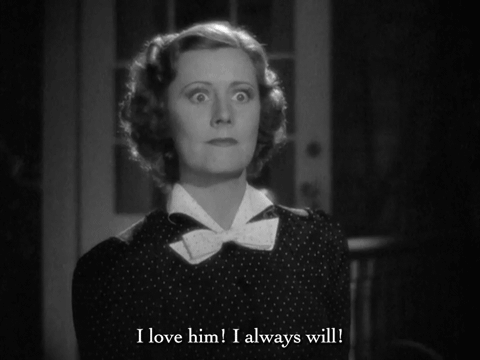





Irene Dunne in Theodora Goes Wild (1936)
#irene dunne#melvyn douglas#theodora goes wild#1930s#film#movies#black and white#comedy#actress#my gifs :)#irene dunne please call me
20 notes
·
View notes
Text

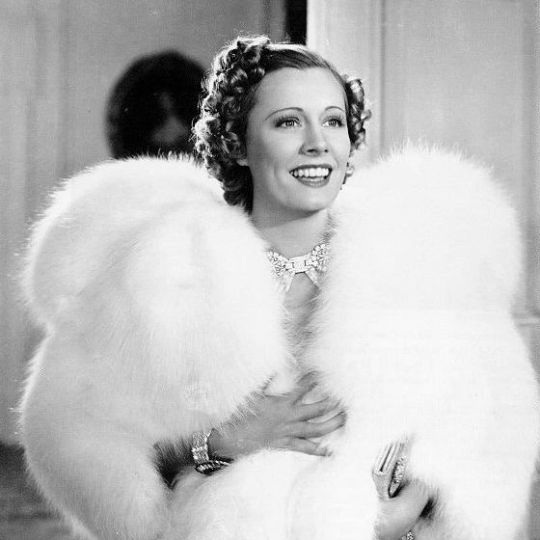
Propaganda
Dorothy McGuire (Swiss Family Robinson, Old Yeller, Gentleman's Agreement)— Kinda the original MILF, but to call her that feels offensive because she always played the most gentle and kind mothers imaginable. She's more like a MILC (mother I'd like to cuddle). She also had a wonderfully soft voice.
Irene Dunne (The Awful Truth, Theodora Goes Wild, My Favorite Wife)— The first time I saw her in Theodora Goes Wild she struck me dumb because who is that BEAUTIFUL woman being so funny and clever??? She was primarily known as a dramatic actress (and believe you me those are muscles she can FLEX, Penny Serenade hurts my feelings) but she’s also one of the funniest screwball leading ladies I’ve ever seen. Her films with Cary Grant are especially charming, but all her characters have this knowing quality in the heart of them that’s so intriguing, and her screwball girlies have this freedom to go after what (or who) they want that is delightfully subversive. I want to be her, I want to fuck her, I want to see every movie she’s ever done, she is a brilliant actress and she is my dream woman.
This is round 1 of the tournament. All other polls in this bracket can be found here. Please reblog with further support of your beloved hot sexy vintage woman.
[additional propaganda submitted under the cut]
Dorothy McGuire:

Irene Dunne:
irene excelled in screwball comedies, musicals, melodramas...she could do it all. she often played elegant society ladies and brought sparkling charisma and poise for days to anything she did, and sang like an angel (she pursued opera before going into moves), her rendition of jerome kern's "smoke gets in your eyes" in roberta moves me to tears every time.
youtube
A fantastic star of screwball comedies Irene Dunne is an undersung hot woman in my opinion. She rose to fame in her roles alongside the likes of Cary Grant, and was usually the funniest person in her movies. And the hottest.
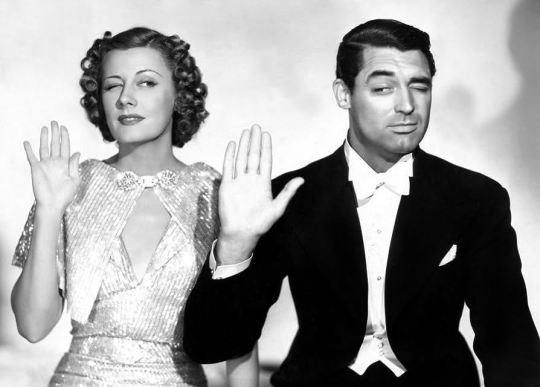
She's snarky, and quick, prone to rolling her eyes, and eager to trip her counterparts up. In short, she was a devilish, charming, problem of a woman in many of her films, the pinnacle of hotness.
She’s so gorgeous and funny and her way of acting is so fresh and timeless! She’s the complete package of hotness to me with her talents, humor, and, of course, hot looks. I named my left tit after her to hopefully attract even a smidgen of her beauty and charm.

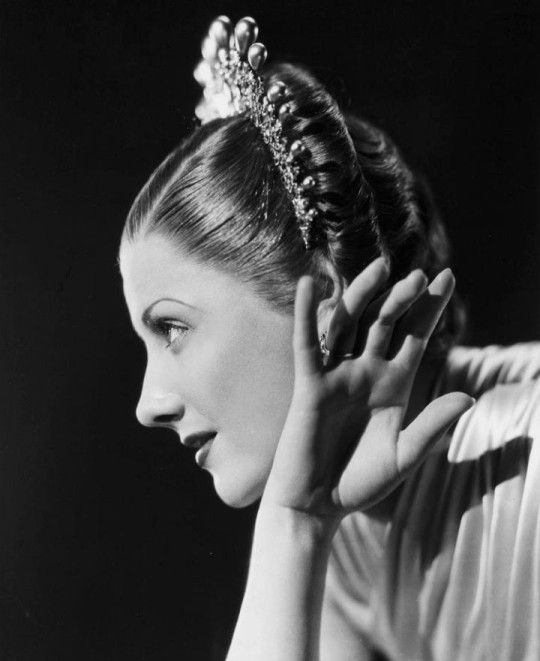
95 notes
·
View notes
Text
ZIEGFELD FOLLIES
April 8, 1946
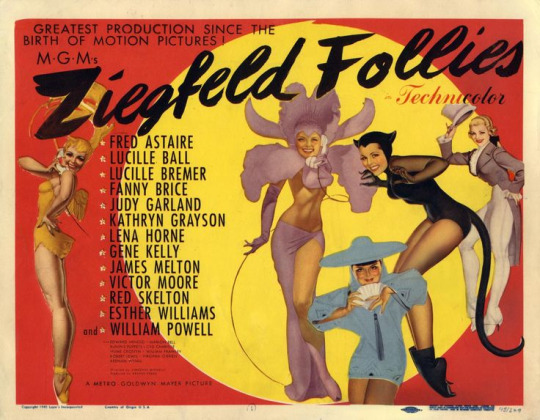
Directors: Lemuel Ayers, Roy Del Ruth. Vincente Minnelli, George Sidney, Norman Taurog, Charles Walters. Robert Lewis Producer: Arthur Freed for Metro Goldwyn Mayer
The shooting schedule ran between April 10 and August 18, 1944, with retakes plus additional segments filmed on December 22, 1944 and then between January 25 and February 6, 1945. The film was first proposed in 1939.
Synopsis ~ We meet a grayed, immaculately garbed Florenz Ziegfeld, Jr. in Paradise (his diary entry reads "Another heavenly day"), where he looks down upon the world and muses over the sort of show he'd be putting on were he still alive.
PRINCIPAL CAST

Lucille Ball ('Here's to the Ladies') is appearing in her 64th film since coming to Hollywood in 1933.
Fred Astaire ('Here's to the Ladies' / Raffles in 'This Heart of Mine' / Tai Long in 'Limehouse Blues’ / Gentleman in 'The Babbit and the Bromide') also appeared with Lucille Ball in Roberta (1935), Top Hat (1935), and Follow the Fleet (1936). His name was mentioned twice on “I Love Lucy.”
Lucille Bremer (Princess in 'This Heart of Mine' / Moy Ling in 'Limehouse Blues')
Fanny Brice (Norma Edelman in 'A Sweepstakes Ticket') appeared in the original stage version of many editions of The Ziegfeld Follies on Broadway.
Judy Garland (The Star in 'A Great Lady Has An Interview') also starred with Lucille Ball in Thousands Cheer (1943).
Kathryn Grayson (Kathryn Grayson in 'Beauty') also starred with Lucille Ball in Thousands Cheer (1943).
Lena Horne (Lena Horne in 'Love') also starred with Lucille Ball in Thousands Cheer (1943).
Gene Kelly (Gentleman in 'The Babbit and the Bromide') also starred with Lucille Ball in Thousands Cheer (1943), Du Barry Was A Lady (1943), and A Guide for the Married Man (1967). He made an appearance on the Lucille Ball special “Lucy Moves to NBC” (1980).
James Melton (Alfredo in 'La Traviata')
Victor Moore (Lawyer's Client in 'Pay the Two Dollars')
Red Skelton (J. Newton Numbskull in 'When Television Comes') also starred with Lucille Ball in Having Wonderful Time (1938), Thousands Cheer (1943), Du Barry Was A Lady (1943), and The Fuller Brush Girl (1950). On TV he appeared on “The Lucy-Desi Comedy Hour” in “Lucy Goes To Alaska” (1958). Ball and Skelton appeared in numerous TV specials together.
Esther Williams (Esther Williams in 'A Water Ballet') also appeared with Lucille Ball in Easy To Wed (1946).
William Powell (Florenz Ziegfeld Jr.) also played the same character in The Great Ziegfeld (1936).
Edward Arnold (Lawyer in 'Pay the Two Dollars') appeared with Lucille Ball in Roman Scandals (1933) and Ellis in Freedomland (1952).
Marion Bell (Violetta in 'La Traviata')
Cyd Charisse (Ballerina in 'Beauty') also starred with Lucille Ball in Thousands Cheer (1943).
Hume Cronyn (Monty in 'A Sweepstakes Ticket') was honored by The Kennedy Center in 1986, at the same ceremony as Lucille Ball.
William Frawley (Martin in 'A Sweepstakes Ticket') played the role of Fred Mertz on “I Love Lucy” and “The Lucy-Desi Comedy Hour”. He also appeared on “The Lucy Show,” his final screen appearance.
Robert Lewis (Chinese Gentleman in 'Limehouse Blues' / Telephone Voice in 'Number Please')
Virginia O'Brien (Virginia O'Brien in 'Here's to the Ladies') also starred with Lucille Ball in Thousands Cheer (1943), Du Barry Was A Lady (1943), and Meet The People (1944).
Keenan Wynn (Caller in 'Number Please') appeared with Lucille Ball in Easy To Wed (1946), Without Love (1945), and The Long, Long Trailer (1954).
SUPPORTING CAST

Ziegfeld Girls
Karin Booth
Lucille Casey
Aina Constant
Elizabeth Dailey
Frances Donelan
Natalie Draper
Karen X. Gaylord
Aileen Haley
Carol Haney
Shirlee Howard
Margaret Laurence
Helen O'Hara
Noreen Roth
Elaine Shepard
Kay Thompson
Dorothy Tuttle
Dorothy Van Nuys
Eve Whitney - appeared on “I Love Lucy” episode “The Charm School” (ILL S3;E15).
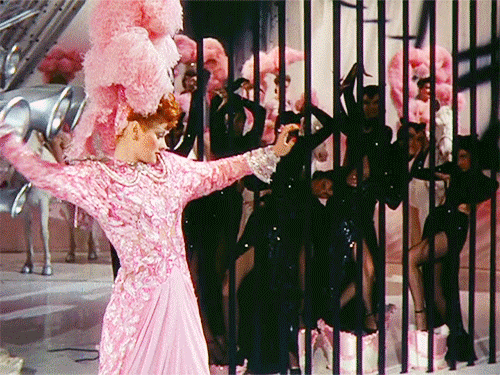
Dancers
Gloria Joy Arden
Jean Ashton
Irene Austin
Judi Blacque
Bonnie Barlowe
Norman Borine
Hazel Brooks
Ed Brown
Kathleen Cartmill
Jack Cavan
Marilyn Christine
Laura Corbay
Rita Dunn
Meredyth Durrell
Shawn Ferguson
Jeanne Francis
Jean French
Mary Jane French
David Gray
Bill Hawley
Doreen Hayward
Charlotte Hunter
Virginia Hunter
Patricia Jackson
Margaret Kays
Laura Knight
Laura Lane
Dale Lefler
Melvin Martin
Diane Meredith
Lorraine Miller
Joyce Murray
Janet Nevis
Ray Nyles
Billy O'Shay
Jane Ray
Dorothy Raye
Beth Renner
Melba Snowden
Walter Stane
Ivon Starr
Robert Trout
Chorus Boys
Rod Alexander
Milton Chisholm
Dick D'Arcy
Dante DiPaolo
Don Hulbert
Herb Lurie
Matt Mattox
Bert May - appeared on “The Lucy Show” in “Lucy and Tennessee Ernie Ford”
Jack Purcell
Tommy Rall
Ricky Ricardi (!)
Alex Romero
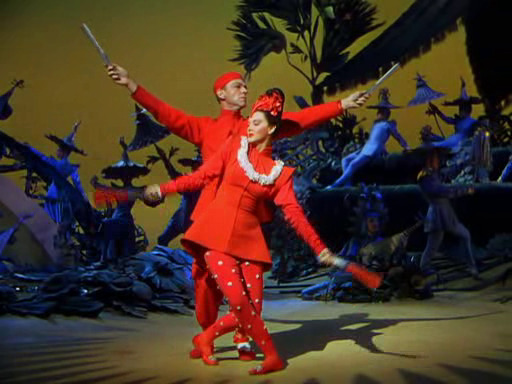
“LIMEHOUSE BLUES” starring Fred Astaire, Lucille Bremer, and Robert Lewis
Robert Ames (Masked Man)
James Barron (Couple with Banners)
Eleanor Bayley (Couple with Branches)
Mary Jo Ellis (Couple with Banners)
Sean Francis (Ensemble)
James King (Rooster)
Harriet Lee (Bar Singer)
Eugene Loring (Costermonger)
Charles Lunard (Masked Man)
Patricia Lynn (Ensemble)
Ruth Merman (Ensemble)
Garry Owen (1st Subway Policeman)
Ellen Ray (Couple with Parasols)
Jack Regas (Masked Man)
Billy Shead (Couple with Parasols)
Ronald Stanton (Couple with Branches)
Wanda Stevenson (Ensemble)
Ray Teal (2nd Subway Policeman)

“LOVE” starring Lena Horne
Juliette Ball (Club Patron)
Lennie Bluett (Dancer)
Suzette Harbin (Flirt)
Avanelle Harris (Club Patron)
Maggie Hathaway (Dancer)
Charles Hawkins (Club Patron)
Marie Bryant (Woman Getting Her Man Taken)
Cleo Herndon (Dancer)

“THIS HEART OF MINE” starring Fred Astaire and Lucille Bremer
Helen Boyce (Countess)
Feodor Chaliapin Jr. (Lieutenant)
Naomi Childers (Duchess)
Charles Coleman (Majordomo)
Sam Flint (Majordomo's Assistant)
Sidney Gordon (Masked Man)
Count Stefenelli (Count)
Robert Wayne (Dyseptic)
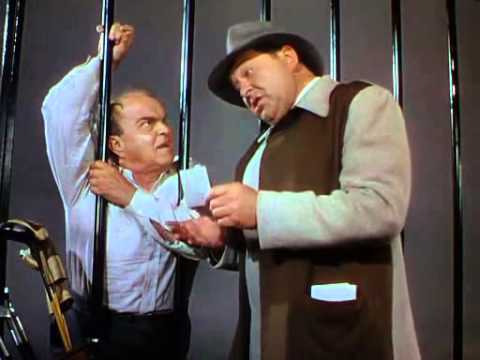
“PAY THE TWO DOLLARS” starring Edward Arnold and Victor Moore
William Bailey (Subway Passenger)
Joseph Crehan (1st Judge) - played a Detective on “I Love Lucy” “The Great Train Robbery”
William B. Davidson (2nd Judge)
Eddie Dunn (3rd Subway Policeman)
Harry Hayden (Warden)
George Hill (2nd Subway Policeman)
Wilbur Mack (Subway Passenger)
Larry Steers (Magistrate)
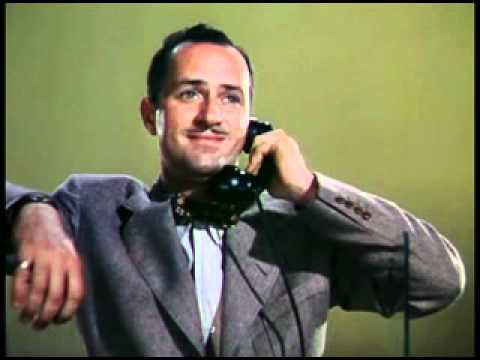
“NUMBER PLEASE” starring Keenan Wynn
Peter Lawford (Voice of Porky)
Grady Sutton (Texan)
Audrey Totter (Phone Operator Voice)
Kay Williams (Girl)
OTHERS
Bunin's Puppets
Elise Cavanna (Tall Woman)
Jack Deery (Man)
Rex Evans (Butler in "A Great Lady Has An Interview”)
Sam Garrett (Roping / Twirling Act)
Silver (Horse in "Here's to the Ladies')
Arthur Walsh (Telegraph Boy in "A Sweepstakes Ticket") - appeared on “I Love Lucy” in “Lucy Has Her Eyes Examined” (ILL S3;E11).
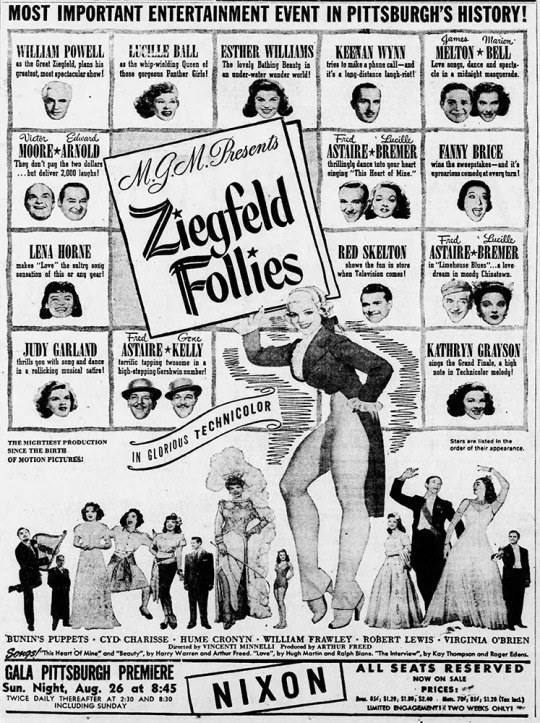
‘FOLLIES’ TRIVIA
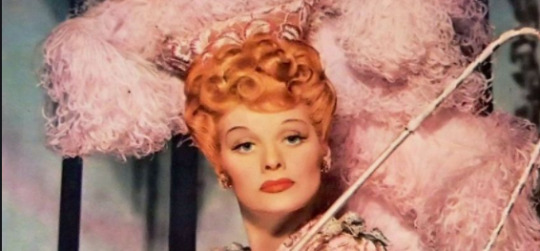
Sidney Guilaroff, Lucille Ball’s hair dresser, who takes responsibility for her famous ‘golden red’ for this movie, becoming her trademark color.
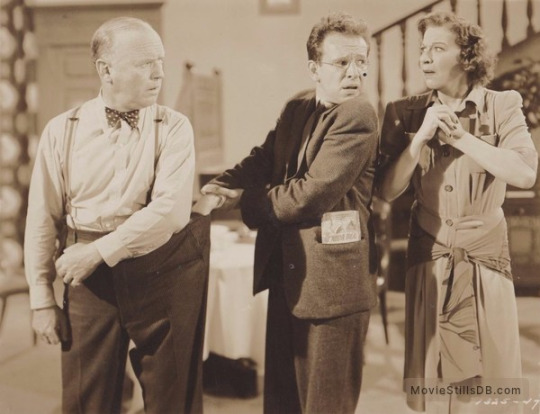
Although they appear in different segments, this is the only feature film collaboration between “I Love Lucy co-stars" Lucille Ball and William Frawley. Coincidently, Frawley's character in this film shares a striking similarity with his iconic character of Fred Mertz on “I Love Lucy.” In this film he plays a money-hungry curmudgeon of a landlord, much like the show. In the above photo, he appears with director Minnelli and co-star Brice.
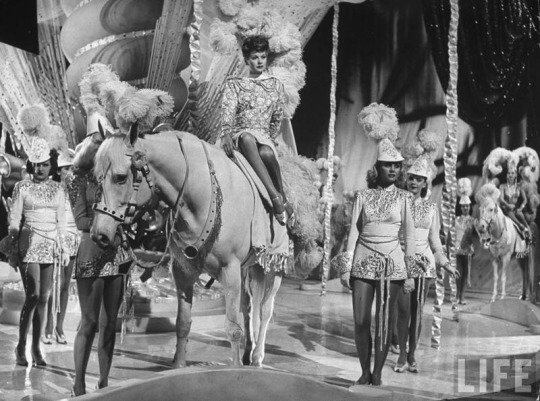
The horse ridden by Lucille Ball is the Lone Ranger's Silver!
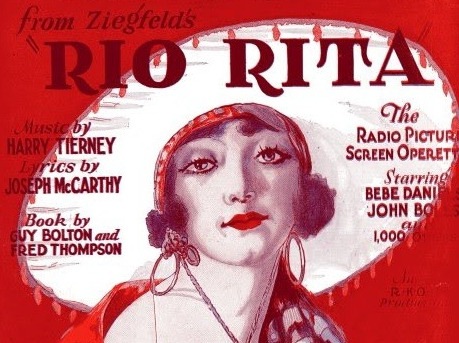
Lucille Ball was actually fired by Ziegfeld from his road company production of Rio Rita in the 1930s.
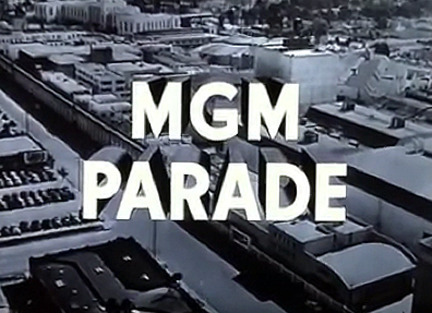
In February 1956, Lucy and Desi appeared on “MGM Parade” to promote their MGM film Forever Darling. The show also included footage of Lena Horne singing from Ziegfeld Follies.
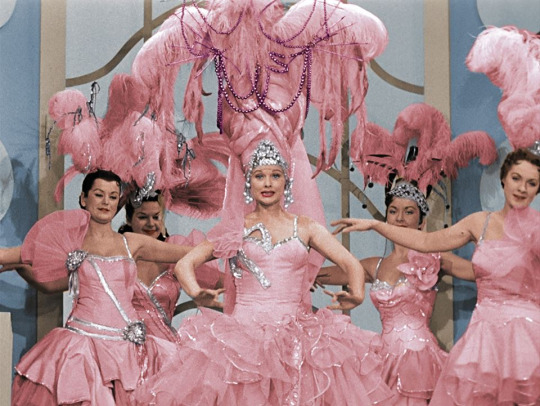
Lucy also played a showgirl in pink in “Lucy Gets Into Pictures” (ILL S4;E19) aired on February 21, 1955. The scene was inspired by Ziegfeld’s legendary stage shows featuring beautiful women wearing elaborate costumes navigating long staircases. To solidify the comparison, Ricky says he is going to a meeting with Mr. Minnelli. Vincente Minnelli was one of the directors of Ziegfeld Follies.

Lucy Ricardo had previously cavorted around in a lampshade in the manner of a Ziegfeld girl in both the unaired pilot and “The Audition” (S1;E6).
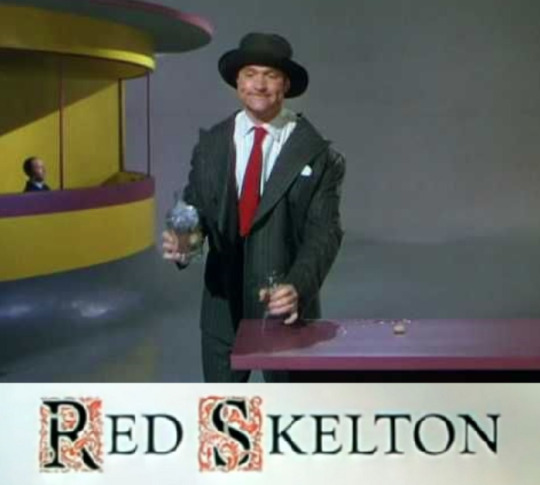
Ziegfeld Follies includes a sketch for Red Skelton called “When Television Comes” aka “Guzzler’s Gin” in which a (future) television spokesman gets increasingly sloshed on his product. This sketch was an obvious influence on Lucy’s Vitameatavegamin routine in “Lucy Does a TV Commercial” (ILL S1;E30) aired on May 5, 1952.
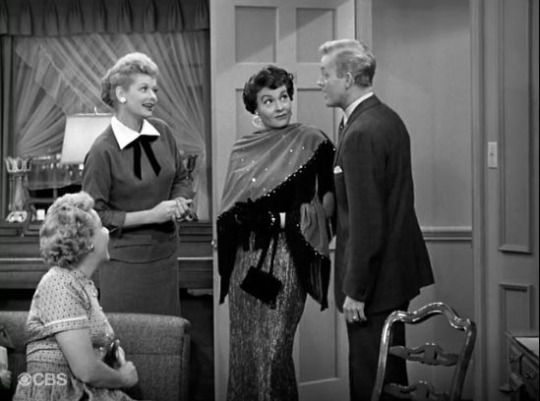
Ziegfeld Girl Eve Whitney appeared on “I Love Lucy” episode “The Charm School” (ILL S3;E15). She used her own name for the character.
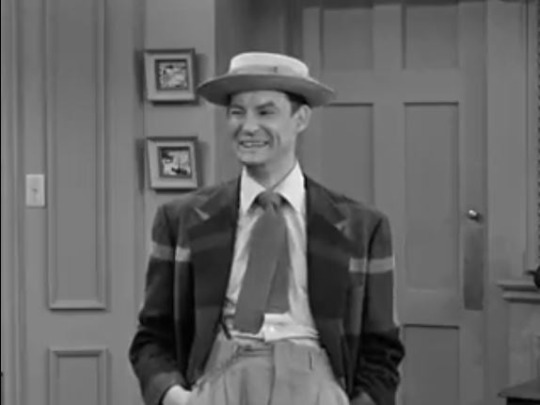
The Telegraph Boy in "A Sweepstakes Ticket" Arthur Walsh - appeared on “I Love Lucy” in “Lucy Has Her Eyes Examined” (ILL S3;E11) as Arthur ‘King Cat’ Walsh. He teaches Lucy how to jitterbug.
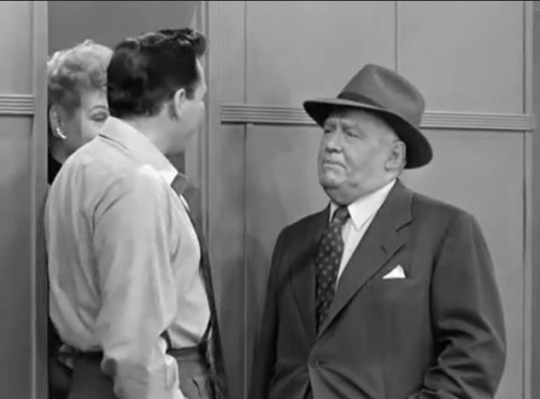
The first Judge in the “Pay the Two Dollars” James Crehan also played the Police Detective on “I Love Lucy in “The Great Train Robbery” (ILL S5;E5) first aired on October 31, 1955.
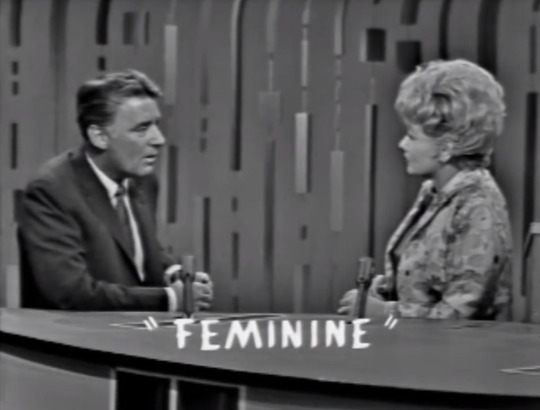
Porky, a voice on the telephone in “Number Please” Peter Lawford, played “Password” against Lucille Ball on September 24, 1964. At the time, Lawford was married to President Kennedy’s sister, Patricia. On November 26, 1968, Ball was a guest on “The Tonight Show” when Peter Lawford was sitting in for Johnny Carson.
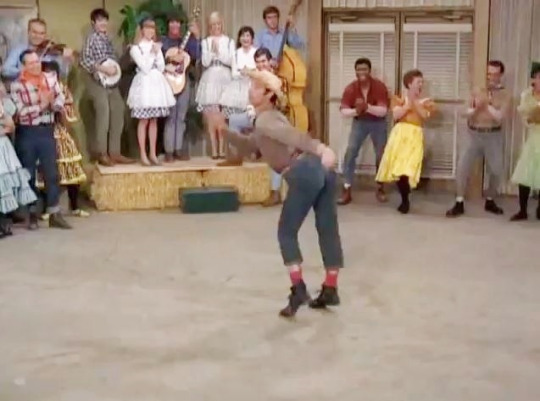
Chorus Boy Bert May appeared as a solo dancer on “The Lucy Show” in “Lucy and Tennessee Ernie Ford” (TLS S5;E21) in February 1967.

In the dressing room, Lucy jokes with Fanny Brice, one of the funniest women in showbusiness. This was the only time Ball and Brice collaborated and was Brice’s last film.

Ziegfeld’s follies began on Broadway, so it was appropriate that the show featured past and future Broadway musical stars:
Lucille Ball ~ Wildcat (1960)
Carol Haney ~ The Pajama Game (1954)
Tommy Rall ~ Call Me Madame (1950)
Fanny Brice ~ The Ziegfeld Follies
Marion Bell ~ Brigadoon (1947)
Victor Moore ~ Anything Goes (1934)
There was a lot of material that was not filmed, but written and cast. Some of the original skits would have added “Lucy” performers Mickey Rooney, Ann Sothern, and Van Johnson to the cast.
#Ziegfeld Follies#Lucille Ball#Florenz Ziegfeld#1946#MGM#Fanny Brice#Fred Astaire#William Frawley#Arthur Walsh#Eve Whitney#Bert May#peter lawford#James Crehan#I love lucy#Red Skelton#Keenan Wynn#Gene Kelly#Judy Garland#Esther Williams#Lucille Bremer#Lena Horne#Vincente Minnelli#William Powell#Cyd Charisse
60 notes
·
View notes
Text
Astaire & Rogers Rewatch Part 3: Roberta
• The Gay Divorcee was a smash hit, raking in almost $600k in profit for RKO during the Depression. It was also nominated for Best Picture. So then why are Astaire and Rogers not the headliners for Roberta? No clue.
• As dumb as that decision was and is, in some ways, it makes their parts even more enjoyable. As the secondary pair, they don’t have to deal with misunderstandings and contrived plot devices keeping them apart or interfering with the development of their relationship. From the moment they’re on screen together, they’re a pair.
• Their romance in Roberta is of two teenage sweethearts reuniting as adults and instantly falling back in step and in love with one another. The warmth and friendliness of their relationship, which I believe mirrors the true relationship between Astaire and Rogers in many ways, is one of the main reasons I adore this film. There are several scenes/moments where they seem to be themselves and it works perfectly.
• Our characters/actors: Huck (Fred Astaire), Lizzie (Ginger Rogers), John (Randolph Scott), Stephanie (Irene Dunne).
• Love their names in this film: Huck (short for Huckleberry) and Liz. A vast improvement, especially for Rogers who has so far been Honey and Mimi.
• Of course for plot reasons Huck’s teenage sweetheart will be in the exact same place he ends up. But it’s worth noting that he requests for John to ask his aunt about Lizzie. He intends to look her up himself.
• Could John be a himbo?? He’s handsome, kinda dumb, but very kind.
• I like how Liz, in her alter ego as a Polish countess, continues throwing a tantrum even though John pushes her to the couch twice. Rogers doesn’t get enough credit for her slapstick abilities. She also somehow makes the word “orchestra” seem very suggestive.
• Love how Huck slides in towards the elevator in his hast to meet Lizzie again. She’s not mad to see him either, only worried he’ll blow her cover. Which he immediately almost does.
• A snarky reunion:
Liz, as the Countess: “Huck is for Huckleberry, n’est-ce pas?”
Huck: “Uhh yes, a couple of n’est-ce pas.”
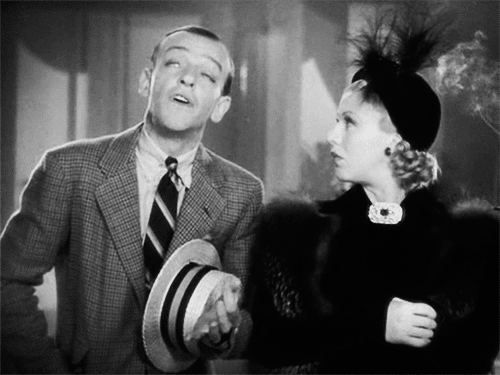
• His face at being called a piccolo player is only bested by Liz’s barely concealed glee at Huck being demoted this way. In their first interaction, he calls her babe, toots, and playfully bites her hand and she puffs smoke right in his face. I love it.
Not for nothing, later in the film he will also call John babe and toots. Huck is an equal opportunity complimenter.
• Their relationship is established immediately as he celebrates her success and beauty. There’s no rivalry or obstacles between them, not even her stage name. While she is careful to remove her hand from between his when their private moment is interrupted, she doesn’t mind it being known she’s going off somewhere with him.
• Irene Dunne has a fine singing voice but it’s just not what I came to this movie to hear.
• Huck’s face as he watches Liz sing is adorable. Maybe a tad overdone but incredibly sweet.
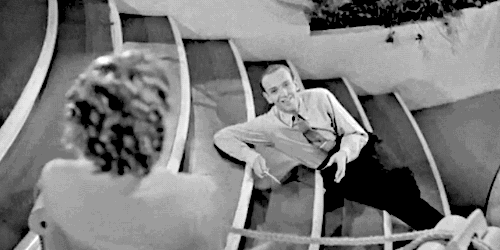
(gif credit @themaladjustedjester)
• It’s a bit irritating that Rogers is forced to sing and speak in her fake Polish accent for most of the film but dang she does an amazing job with this song. It’s a full-body performance and she does it with gusto.
• I adore the way Astaire tosses the baton over his shoulder as soon as she comes to sit with him. He’s just like, don’t need that anymore.
• So cute as they reminisce about their younger years:
Liz: “You know I think I was in love with you then, Huck.”
Huck: “I know you were.”
Liz, mildly offended: “Youuuu.”
Huck: “Meeee. And what’s more, I was madly in love with you.”
• Their entire exchange is funny and wonderful. The teasing, the flirting, the declaration of past love for one another that is obviously still true. How he punctuates certain moments with a bit of tap for emphasis. They smile naturally and it feels like two friends talking. This could be AU Fred and Ginger’s real-life story and I would believe it.
• Talking about how she won a beauty contest:
Liz: “Well, you won it for me. How did you get all the men from the overall factory to vote for me?”
Huck, very pleased with himself: “That was easy. I showed them a picture of Lillian Russell.”
Liz, incensed: “Lillian Russell? Well what was the matter with my picture?”
Huck: “Well if you must know, we got a lot of votes from the farmers with a picture of a prize heifer.”
Liz, about to playfully sock him: “Oh youuuu.”
• “I’ll Be Hard to Handle” is a special dance for many reasons including that the taps were not dubbed over later. Since they used the original sound, we can hear both Astaire and Rogers giggling and whooping throughout the dance.
Usually, Astaire recorded the taps in post-production since the sound could not pick them up very well during filming. Hermes Pan, Astaire’s choreography partner, often recorded Rogers’ taps since she was typically off filming a different movie by then.
• Astaire often gets a lot of the credit for their dancing because he worked tirelessly on the choreography. Rogers was often away filming non-musical roles while he did this. She was in three other films in 1935 alone, in addition to both Roberta and Top Hat with Astaire. But she put in a lot of hard work too. While filming those other roles, she learned the choreography from Pan so when she showed up for the six weeks of rehearsal, she was prepared.
• And somehow this number feels perfectly spontaneous. At the start, as he pulls her in, she looks at him flirtatiously and it’s not acting. She waits for him to come spin them around and of course it’s part of the choreography but it’s a lovely feeling of anticipation all the same. Several times they appear lost in their own world, dancing for one another. They also seem to be talking to one another quietly throughout most of the dance. Like before in their films, you can see the acting start and stop pretty clearly.

• When one of them does a little extra dance, the other watches in true appreciation and delight. Again, not acting. Most instances where they make eye contact they look very pleased with themselves. This is the closest we’ll ever get to seeing what Astaire and Rogers were like in rehearsals, complete with the in-joke bugle call.
• To understand better the moments of reality vs. acting, just look at the sequence where they challenge each other and argue using different dance steps. All acting. Then look at their faces immediately after this sequence ends and they enter the final moments of the dance. All them.
Side note: don’t miss how Astaire claps his hands together to make the smacking noise when she slaps him.
• While watching a private fashion show, John and Huck dislike a gorgeous black satin gown that’s low cut and with an almost completely open back because they think it’s too revealing. But later Rogers is going to wear almost this same gown and will look marvelous in it during the “Smoke Gets in Your Eyes” dance.
• After selecting a new gown, Liz teases Huck that “tall, handsome gentleman with large bank accounts will be asking for my telephone number. And getting it.” He replies, “And won’t they be surprised when I answer?”
• Upon hearing that John’s terrible ex, who has just arrived to undump him now that he’s rich and famous, will be leaving on Saturday, Huck departs with this line: “Goodbye, John. I’ll see you Sunday.”
• Irene Dunne definitely enjoys her few seconds of being spun around with Astaire. But who wouldn’t?
• Huck’s line to Sophie, “Gee, darling, you look terrible,” is such a burn and I love it.
• Another thing I have a soft spot for is Astaire’s piano playing. It’s energetic and fun and he doesn’t do it nearly enough imo.
• Astaire sings 3 songs (I’m not counting the fashion show “song”) in Roberta but they all have that very conversational style that suits him. And in fact both “I Won’t Dance” and “Lovely to Look At” are duets framed as a conversation with Rogers. My favorite part of “I Won’t Dance” is this exchange:
Astaire: “You know what? You’re lovely.”
Rogers: “And so what? I’m lovely.”
Astaire: “But oh what you do to me.”
• I also have to mention the little callback to “The Continental” as well as the strange rhyme of “for heaven rest us, I’m not asbestos”??
• Notice how this solo routine for Astaire is not interrupted by any cuts to his face or feet like previously solos? He got his way with the camera work.
• “Smoke Gets in Your Eyes” is a lovely song that I don’t necessarily want Irene Dunne to sing, not when Ginger Rogers is in the same film.
• Rogers’ acting when Huck talks rhetorically about wanting to marry Liz is fabulous. First, she has to be incensed at the mention of a “Liz” when publicly she’s still known as the Countess. Then she’s flustered that he’s just admitted he wants to marry her. And then she glares at him when he takes up the joke and describes his fiance-to-be as “simple” with “big feet.” And all of that happens in about three seconds. The way she sharply looks him up and down always makes me snicker.
• This lengthy fashion show is something else I usually skip. Was there a line of gowns that were sold as movie tie-in merchandise? I highly doubt it. But why else is this so long??
• When Astaire sings the lyrics “and heaven to kiss,” his voice drops and Rogers glances at him. Huck and Liz have most certainly been kissing off screen.
• Absolutely love how the lyrics of “Lovely to Look At” change for Astaire and Rogers. Instead of a “most impossible scheme come true, imagine finding a dream like you,” Rogers sings that he is her “most impossible dream come true, imagine finding a boy like you.” She takes his arm and on the lyrics “it’s thrilling to hold you terribly tight,” he squeezes her hand.
• Their dance, set to “Smoke Gets in Your Eyes,” is slow and stunning, one of the most beautiful they created. It’s full of soft looks between them. Rogers spends most of the beginning gazing at him lovingly. Not to be outdone, Astaire does the same when she’s turned away or not looking at him. He also has a small, private smile soon after they begin. It’s lovely.
• The duet is romantic and yet they don’t embrace fully until about a minute in. Instead, they hover near one another, faces angling together, small touches here and there. Holding fingertips for a particular move. His fingers briefly touch her ribs when she places his hand there for a beat. It’s a dance of deep partnership and love, not courtship. Neither needs to woo the other.
• And when they do embrace, he holds her close for a prolonged moment before moving into the next step. As he does, that private smile sneaks out again.
• The sudden dip is another example of Rogers trusting Astaire. She looks magnificent in the pose too. They both do.

• She lays her head on his shoulder, his hand resting gently on her hair, and her arm is around him. It’s a very intimate pose, made even more so by how he tilts his head towards her and his lips are very close to her brow. And there again, that smile.
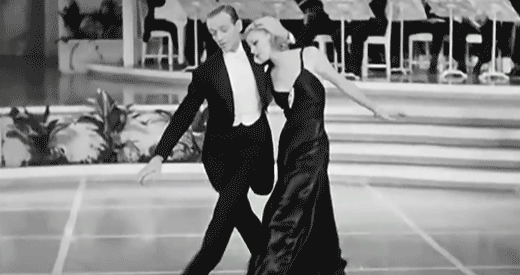
• When the music becomes playful, Rogers glances over her shoulder at him and finds his eyes are already on her. Both of their faces soften.
• And ending a sumptuous dance with a backwards leap up three stairs. Super casual. They walk off the way they began, their arms linked.
• Speaking of casual, Huck and Liz get engaged in the most laid back way ever. Perfect for them.
• I have always loved Stephanie’s expression when she realizes just how dumb (but sweet) John is.
• The reprise of “I Won’t Dance” ends the film. Newly engaged but still in the same clothes they just performed a slow, romantic duet in, Astaire and Rogers perform a much more energetic dance. She makes her dress work for her superbly. The way they dance is very like “I’ll Be Hard to Handle,” which shows that this celebratory number is Huck and Liz, not the bandleader and the Countess performing for a crowd. And the choice of song is fitting since in the lyrics he said he couldn’t dance with her for fear he’d fall in love with her. But now they have danced quite intimately and they’re engaged. Might as well keeping dancing together.

• Soooo another film finished! We’re getting into some of the best ones now. Up next: Top Hat.
• Also if fanfiction is your thing, here’s a very sweet one for this film.
#fred astaire#ginger rogers#roberta#classic hollywood#old hollywood#astaire and rogers rewatch#fred and ginger#y'all have got me making gifs now for this#and by y'all i mean my own perfectionism and obsession
33 notes
·
View notes
Note
recommend me a few lesser-known pre-1965 movies!!
hello anon! i’m gonna recommend mostly happy stuff because it is one in the morning and i think you deserve some happy recs! also these are gonna be in chronological order because my virgo ass wouldn’t have it any other way.
firstly! they’re not lesser-known BUT i would be remiss if i didn’t recommend bringing up baby (1938) and the philadelphia story (1940,) starring my #1 hollywood crushes miss katharine hepburn & cary grant! (these are two of my favorite movies of the era; the philadelphia story is my fourth favorite movie of all time so forgive me if i wax poetic.)
next, my favorite wife (1940.) grant again with randolph scott and irene dunne! (if you like that one, please take a look at this twitter thread of cary grant & randolph scott taking homoerotic photos together. you’re welcome.)
also with grant: arsenic and old lace (1944,) which is just a complete blast. very silly — grant thought his performance was too over the top — but i love it. there’s murder! teddy roosevelt jokes! a dude who tries so hard (seriously, so fucking hard) to be eeevil!
in 1954, mgm released a musical remake of the philadelphia story called high society, because bing crosby really wanted to Sing A Song, i guess! it stars grace kelly, light of my life and h-wood crush #3, in the hepburn role with crosby and frank sinatra as her love interests. not as good as the original but FUN (frank and bing get smashed and sing a song making fun of rich people, if that’s your jam.)
if you like foreign films, i adored cléo from 5 to 7 (1962,) the first agnes varda film i watched. it’s gorgeous and sad but also manages to be very fun!
if you like shakespeare, one of my favorite adaptations is the 1964 bbc telefilm hamlet at elsinore starring christopher plummer as hamlet to michael caine’s horatio! bonus: this one is on youtube :-)
LASTLY, bonus post ‘65 recommendation because i love it so much i recommend it to everyone — bob & carol & ted & alice (1969!) it’s insane in the best way. natalie wood talks her husband and their friend-couple into having a mènage a quartre! there are snappy outfits! it’s very sixties and would never ever ever get made today.
i hope these get you started on a journey with films! if you like them please feel free to come back or recommend films to me ♥️
3 notes
·
View notes
Text
Episode 13: His Girl Friday & Roman Holiday
Please consult these Instagram slideshows for accompanying images: His Girl Friday Roman Holiday
Both:
Welcome to The Costume Plot.
Jojo:
I'm Jojo Siu.
Sarah:
and I'm Sarah Timm. We're professional designers with a passion for costume design and the performing arts. Our podcast does contain spoilers.
Jojo:
We hope you'll join us every other week as we delve into the wonderful world of costume design in The Costume Plot. [music]
All right.
Sarah:
[sings] Welcome back, welcome back.
Jojo:
Welcome to The Costume Plot. [both laugh]
Sarah:
It's us again!
Jojo:
Yaaaay! what are we on now? Month four, five?
Sarah:
Good question. Yeah?
Jojo:
I've lost track. It means we're that far in.
Sarah:
and we're still enjoying it...
Jojo:
That's a good sign.
Sarah:
...which is good.
Jojo:
Yes. Some little bits of homework, but at least we're enjoying the process.
Sarah:
Hey, it's-- every time I'm like, "Oh, no, I have to sit down and watch that movie," I end up really enjoying myself. And I do my research. And I like the research part. So I'm still having fun. Even sometimes I forget to make time to do it. [both laugh]
Jojo:
It's true. All right. So today, our theme is going to be black and white movies.
Sarah:
Yeah.
Jojo:
We haven't really covered this yet. So this is kind of a new platform to talk about costumes. And one of the things that we are going to talk a lot about, or I assume we're going to talk a lot about, Sarah, is that, you know, how do we do costumes? And how do we differentiate characters when you're limited to a color palette of only monochrome.
Sarah:
Yep.
Jojo:
Because you know, now we're not looking at 1000s of saturate colors and ways to parallel you know, characters and things like that. So there's a very fine art of knowing how to balance textures and patterns and things like that in a black and white film. So, really excited about that. I'm going to be going first today, so I'm super excited.
Sarah:
Yay!
Jojo:
I'm going to be covering his girl Friday, which features Cary Grant and Rosalind Russell. I'll tell you a couple fun facts about that in a second, but it was released in 1940. So there's a lot of 1940s silhouettes that you'll see in our costumes for this one. It was directed by Howard Hawks, who actually was a humongous conglomerate in the film industry. He did Scarface, Bringing Up Baby...
Sarah:
Wow.
Jojo:
... Gentlemen Prefer Blondes, Only Angels Have Wings. So he's actually worked with Cary Grant quite a few times. I think Russell-- or sorry, Rosalind Russell was probably not one of his regulars. But she got really famous through this movie. So we'll talk a little bit more about that. The costume designer was Robert Kalloch. I don't know if that's how you say his name, K-A-L-L-O-C-H? Someone can correct me out there. He was actually...
Sarah:
"Kall-oak"?
Jojo:
Kalloch...? [both struggle and repeat the name, laughing] Not good at that kind of pronunciation. But he ended up becoming the chief designer for Columbia Pictures. And actually, he was really, really the heyday designer of the 1932 to 1940 period, specifically for screwball comedies, which-- this is considered one. And he also did quite a few projects with Howard Hawks. So "It Happened One Night", he did "The Awful Truth", "Mr. Smith Goes to Washington", and he also did "Only Angels Have Wings" with Howard. So again, a lot of these are much older movies, so if you haven't seen anything prior to like, you know, 2000, then maybe these are some new titles for you. But just know that, you know, these two were really kind of big in their heyday of being in the film industry. And Robert actually went on to be one of the mentors for Adrian, who is well-- very well known for all of his costume designs, pretty much from the 50s on, essentially.
Sarah:
Mmhmm.
Jojo:
So I'm going to talk a little bit about the actors themselves, because again, the Age of Hollywood, especially in the 40s, it very much became about who you knew, the celebrities that you recognized. At least from the kind of common people became... I mean, celebrities are still very important for us today. But there's a lot more celebrities all over. So we see musicians as celebrities, we see, you know, advertisers and promoters as celebrities as well. Whereas this time, it was mostly mostly movie, Hollywood filmmakers, or-- sorry, Hollywood actors and stars that became really in the public eye. So this was actually a piece that focuses a lot on the groundbreaking look at women in a man's world and one of the things that made Rosalind so popular for this movie. Interestingly enough, she was actually-- she jokes that she was the 15th choice because Howard went through basically every other person. Irene Dunne, he went through, I think he went through a Berlin Irving, or I don't know, I'm...
Sarah:
Irving Berlin?
Jojo:
I'm making up names now.
Sarah:
Irving Berlin?
Jojo:
No, no, I'm thinking of the wrong name.
Sarah:
Oh.
Jojo:
...because that's not a female.
Sarah:
That's not a lady, no.
Jojo:
[laughs] But he basically went through the entire list of all the other Hollywood female stars at this time. And basically, I think only one of them was actually unavailable. But I'm pretty sure everyone else on his list basically said no to the project. So interestingly enough, when he ended up with Rosalind Russell, he, you know, multiple times told her and she knew that she was not the first choice. So she found out in the public, because I think it ended up in the news that he had gone through all these other people before asking her, so. What a weird way to walk into a project, knowing that you're not first choice, but she totally ran with this. She ended up actually-- because the dialogue is so snappy in this in this particular film, because it's about reporters, she actually ended up hiring... I can't remember who it said she hired. She hired someone to basically help kind of clean up the dialogue and help them make it faster and make it really-- paced really well. So because of that, Cary Grant actually ended up becoming really good friends with her while they were filming together and ended up asking for his own personal training with the same coach, basically.
Sarah:
cool. It's almost like a script supervisor, but like, your own personal one.
Jojo:
Yeah, yeah, exactly. So again, she really brought a lot to this project. And like, you know, didn't get discouraged by the fact that she wasn't first choice, she just totally jumped right in, and just really gave it 110%, which I really love. And that's very much like her character in the movie as well. So again, she is, you know, the most powerful female in this in this giant room of mostly male actors. And she really carries her own very well. And even in the, you know-- there's small scenes where you could argue that there's some sexism going on, and all of that. But she really holds her own gravitas very well throughout this movie. And I think that they did a really good job of not just making her this kind of meek female that's surrounded by all these other male reporters. She certainly knows how to stand on her own, she's very independent. And they actually do contrast her with another character who is a little bit more seen as weak and naive and more feminine, kind of drawn to her own emotions and overwhelmed by her own emotions. So seeing that in comparison to how she portrays Hildy, who is our main character, you really see a lot of that contrast. And they did that really well. And again, this is in the 1940s, when most women weren't really in what they call a professional environment. You know, they're the professions that were kind of given to women at this time, were either secretaries, teachers, in education, or in the nursing departments. And there's nothing bad about any of these departments. But it was a very limited place for the woman in the work field. And so having her in this role as a reporter really made her stand out against everyone else. So the fact that she made such a huge impression on on women everywhere after this movie, I think it just goes to show how much power she had, even though she wasn't first choice. And how much she made a positive out of this kind of negative start, for lack of a better term.
Sarah:
Well, I mean, on "Drag Race" last week, Anne Hathaway was on and she said she was the eighth choice for "The Devil Wears Prada". So I think you just kind of have to look at it as like, "well, it was meant to be," you know, "none of those other people were right for it, but I am. So I need to take advantage of the fact that I'm here and they're not."
Jojo:
Right, right. Instead of looking at all the negative...
Sarah:
yeah.
Jojo:
... that comes with that. Yeah. Okay, so let me go ahead and share my screen. Alright, so I am gonna pretty much go in order with this movie, there aren't going to be as many costume looks for this particular episode. But a lot of it was because most of this happens, within a span of less than 24 hours. Right? So...
Sarah:
both of our movies do, which is so funny that we picked-- we both picked some, that are like that.
Jojo:
[laughs] Yeah, it's crazy though, 'cause in the-- you know, in this time, you're not really looking at years and years of time. A lot of times you are focusing in on a moment in time, or a span of 24 hours, or even a couple hours. So it's kind of crazy when you're watching the movie because you're not thinking about how little time has passed because it just seems like so much is happening.
Sarah:
Yeah.
Jojo:
And then you're like, "Wait, it's only been 24 hours." [both laugh] So yes, I do love that. So just to give you a little bit of background on the story, and again, there are spoilers. But Rosalind and Cary Grant play Hildy, who's the wife and-- or, ex wife. And Cary Grant plays Walter, and Walter basically runs his own newspaper company. He's really like-- he's always been a reporter that's always after the story. And the opening credits actually start with this whole quote about how, you know, when you're a reporter, it's all about the story. Nothing else matters, to the point where it goes to extremes, like murder, and all these other things in order to get the story. And it's very much kind of the presence of what this story is about. So Walter owns this company. Hildy used to work for the company. But they've since gotten divorced. It's been probably a couple months now since they've gotten divorced. And she's the one who actually asked for the divorce. And her argument in the beginning, or her justification was that Cary basically-- or, I should say Walter. I keep saying Cary, because that's the actor.
Sarah:
'Cause it's Cary Grant, yeah.
Jojo:
Yeah, everyone knows who Cary Grant is. [laughs] But she ends up asking him for a divorce because she believes that he's basically too tied to his work. So he hasn't paid enough attention to her as a woman, he hasn't taken the time to appreciate her and really show her what a husband doting on his wife should look like. And again, you don't really see that change for Cary Grant the entire movie, because I mean, even at the end, I don't think that he necessarily suddenly turns into this doting husband. But you know that because he's not the one who asked for the divorce, he still is very much in love with her. And so the movie is very much about his kind of sneaking around and trying to manipulate the situation so that he can try and win her back. And of course, all of that comes at the cost of a story that they end up breaking onto.
Sarah:
Mmhmm.
Jojo:
So the first scene, when she comes into the office, is actually when she's trying to tell Walter that she is about to get engaged to another man. So she has been dating someone else since they've gotten divorced. She's fallen in love with this man and you meet him. But you don't really know that he's the engagee until she goes into the office and talks about this engagement ring. And she's covered her hands with gloves, so you don't even see that she's actually coming in for this purpose. So the movie really just starts you right in the middle of it. But the first thing that you see her in is this beautiful chevron two-piece suit with matching hat.
Sarah:
Incredible.
Jojo:
I love that the designer has really created such a huge contrast, not just with her and the stripes on her, and like-- the black versus the kind of lighter color. Interestingly enough, they said that the actual garment is supposed to be black and pink, which... it's so funny that this is how it's reading to us, because we always see black and white, or gray. But to know that this is a pink suit gives us a whole different, you know, understanding of this garment. But the opening scene, she walks through the first kind of row of all these other reporters and she's the only thing that stands out. And part of the reason they're able to do that so successfully is because Robert Kalloch, I'm gonna say that name wrong every time, Robert Kalloch ends up keeping everyone else around her in these pretty solid colors, or they're really subtle patterns, if there are any. And because she's the only thing that's got any kind of a vertical--or even pattern--on her body, she's the only thing that you see in the room against everyone else that's in these kind of solid versions, or hues and tones, of gray. Let's see, I think-- I do love also that he has put a lot of the women in these scenes in very powerful colors, because there's only... I think there's maybe one or two other women that she passes in the office. And you can tell one of the other women, who may also be a reporter? You never really see her again after this first scene. But she's also in this really dark black.
Sarah:
Oh.
Jojo:
So that's not her, that's actually the assistant, but you can tell even the assistant is in this more subdued gray behind her really vibrant stripe. Uhhh... nope, I guess I didn't grab it. Well, anyways, she's in essentially a-- what looks like a black two-piece skirt suit. So again, she's one of the ones that kind of stands out against everybody else. But it's really-- in that scene, it's just Hildy and this other woman in this black two-piece suit. So really making our women very strong in this world of kind of... for lack of a better term, hazy looking colors for all the other men. So that way, they really stand out a lot more. So this was something that I wrote just for my own interpretation of this suit. Obviously, I think it's a beautiful stripe. During this time. They also mentioned that because they had to ration everything, since it was entering into World War Two. Robert ended up, you know, kind of changing the direction of the stripes in order to save every piece or scrap of fabric.
Sarah:
Oh!
Jojo:
So you see that not just in the lapels on this, but you also see that in her second suit that she changes into later, to travel. But one of the things I really loved is that, for me, I feel like the stripes in the vertical lines in both of her outfits--so not just in this one, but in the second look that we'll look at--it shows a very tight laced woman, you know, she obviously has to be extremely strong and like hold her own, in a world full of men who are constantly trying to talk over her. And that's a big part of this movie, too, is that every character is constantly talking on top of everyone else, but you really focus in on her verbal language and communication with her ex husband. And you focus on that not just because of their dialogue, but also because I think we see, and focus, on her in the image because of her stripe, too.
Sarah:
Yeah.
Jojo:
So even though she does a lot of sarcastic joking with Walter, and I feel like she's constantly-- she kind of keeps up with his sarcasm really well. But I think, you know... that femininity comes from the fact that she wants to be loved as a wife, and she wants to be treated as a woman. But I think with the stripes, it definitely gives her that more masculine kind of authority or power that she has in the room. And it certainly makes us, the viewers, focus in on her her power a little bit more.
Sarah:
Mmhmm. Totally.
Jojo:
Moving on. So, Walter's first suit. So in contrast to her dark and kind of bold lines, you see Walter in this really kind of pale and subdued... it almost looks like linen? Or... I'm not sure exactly what the material is. But he-- in this particular scene, he's also the only person in this kind of double breasted suit.
Sarah:
Mmhmm.
Jojo:
So that also is another way to sort of stand them out, especially with the limited color, by changing up the silhouette of the jacket and looking at the way the lapels cross. He also-- you do see other reporters and double breasted jackets later, but he's the only one that kind of remains in this lighter hue. So I love that they've definitely kept that to his look the entire time. Again, this is all within 24 hours. So this is literally the outfit he stays in the entire day. [both laugh] So I was like, "great, nice and easy, one and done." I do also love that if you look closer, which... you can't see it as much here. He actually does have a pretty subtle, almost like windowpane, plaid.
Sarah:
Mmhmm.
Jojo:
And again, you don't notice that until you're looking up close and personal, and it's after you're staring at the jacket for, you know, a couple minutes before you notice it. So you don't see it when she first comes in. But that initial contrast of the really light suit versus her really dark stripe is just a really nice way of looking at their characters too. Because I think the light heartedness of his character is very much reflected in how vibrant--or, I say "vibrant," but, you know--how light his suit jacket is.
Sarah:
[laughs] Yeah.
Jojo:
Because even when we see him later with Bruce, who's the engagee, there's this really nice kind of play of different tones of gray. So you see the dark is with Hildy, and the almost black is with Hildy. And then you see the kind of medium tone with Bruce, and then Cary Grant is in the the lightest tone of gray.
Sarah:
Mmhmm.
Jojo:
When we first meet Bruce--again, just looking at the kind of difference in silhouette--you can immediately tell that Cary Grant is our very sharp sleek business man. And he's always in these very straight vertical lines. His suit is very cut. And it's tailored very nicely, and it's much more vertical and slim fitting. Whereas with Bruce, the first time we see him he's in a trench coat. It's almost a little baggy on him, we don't really see the shape underneath. And it also gives him a much more casual, and a little bit of a naive, vibe. And I think he definitely has that throughout the movie. We certainly see him as like-- it almost looks like his mother has kind of dressed him? Like, he's got a nice suit, but it's not quite the same fit. He doesn't take care of himself in the same way that Cary Grant does.
Sarah:
Right.
Jojo:
And even the way that Hildy does. And I think both of them are very Metropolitan in comparison. So yet another comparison of the two of them... this is not the best example of the light versus dark because you don't really see his gray suit yet. But again, just that idea of the the trench coat being kind of oversized on him versus Cary Grant's more tailored jacket.
Sarah:
Oh, wow.
Jojo:
So then, halfway through the day, basically, Hildy ends up telling Walter that she's heading down to Albany with Bruce later that day, like within a few hours' time. And they're basically going down to Albany to get engaged--or, sorry--to get married, and they're bringing his mother with him. So she's trying to plan this train ride to go down to Albany and get married, and get hitched. And of course Walter, you know immediately that everything is kind of working in his brain to try and prevent this from happening. He's trying to get the train schedule changed. Like, he literally is calling people to be like, "Can we stop the train from happening?" Which... it's kind of crazy that he's got that kind of power. But literally doing everything in his power to try and stop her from getting married to this other guy. So of course, the biggest part of this is that there's this big scoop that's happening that all the reporters are trying to get on top of. So the side story, and all of this, is that there's this man, Earl Williams, who has been... I can't remember the exact situation because it was very late at night last night. [laughs] But he basically ends up shooting someone that was unintentional. And of course, his argument is that he didn't do it on purpose. I believe it was a police officer that he ended up shooting, but he didn't do it on purpose. He thinks he's in jail innocently, and all of this other stuff. So all of the reporters are trying to find out what actually happened, why he's claiming himself innocent. He happened to also be talking to a woman, I think they had one conversation. But then the news reporters--and you'll see this a couple times in this movie--you know, the news reporters are all about writing his story. So whether it's true or not, you'll see a lot of them actually make up facts, or they'll over exaggerate what's actually happening. So there's a lot of, you know, false news out there. Which ironically, today that's very applicable. [both laugh]
Sarah:
Buzz word!
Jojo:
...and very, you know, kind of what's happening. So again, this idea that all of them are trying to get the real news out there versus the fake news. And so this huge story kind of falls into their lap. And so, Cary Grant's character knows this. And so he kind of brings it up on a whim, hoping that it'll basically get Hildy convinced to kind of come back and work for him instead of going and getting married. And he knows her well enough to know that that's probably what she'll end up doing. So she keeps getting stalled and stopped. And everything keeps going wrong. Like she-- you know, every time she tries to meet up with Bruce, or every time she tries to get him on the train, something else happens. So there's all these... it's like a series of different things that Cary has basically manipulated to get Bruce in trouble and prevent them from going down to Albany. So this is her in the news reporter room, and you see her with all the other news reporters here. And even though their colors are very similar, just the fact-- again, that she's got the most prominent stripe going on with her two-piece skirt suit. And again, this is another place where they talked about Robert really recycling the direction of the fabric so that he could still reuse essentially every leftover scrap of what they had to make this suit. And it's just so tailored, very well to her body.
Sarah:
Mmhmm!
Jojo:
It fits her beautifully. And again, it just gives her a lot of power in this scene, especially with all the other reporters in the room. I think the only one that really has any kind of texture is this more... dumpy looking character, for lack of a better term. [laughs] And he's kind of like... they're all a little bit goofy. And I think they're all a little bit cutthroat, but not necessarily in a bad way. They're just all trying to scoop the story.
Sarah:
Yeah.
Jojo:
And it's funny, because you'll see all of them appear in and out of the room trying to get the newest scoop. And so they'll all just update stories, and a lot of them are made up, you'll hear them saying things that are totally in contrast with what's actually happened. And they'll just say some random statement to put in the, you know, the front line of their newspaper. So yeah, it's an interesting look at just how false news can travel so easily, and how it can easily be misinterpreted or just mis-told. And of course, Hildy is the one that's trying to honor the original story. So she actually befriends Earl Williams, she goes and talks to him. And again, very much pointing to the fact that as an independent woman in a man's world, she is really the go-getter, she takes a lot of initiative, she knows how to get the right scoop, she knows how to go to the right people to get the story that she needs.
Sarah:
Mmhmm.
Jojo:
Okay, so... one of the things-- we do see her in that pinstripe suit for a good chunk of this scene when she's with the other reporters. But when she first appears, we actually see her in this beautiful fur coat. And again, this is just... again, continuing to show all the different ways in which we have to find other venues, or means, of being able to differentiate characters. And he certainly-- Robert has certainly done that really well, with even just making her the center of focus, because she's totally got a very different texture than everyone else around her. And it's also a much lighter color. So she's the first thing we see in the room. And I think they mentioned this with the movie as well, but she's always kind of the center of attention here. So it's never-- you never lose her on screen. Let's just say that.
Sarah:
Right.
Jojo:
Okay, so this is another example of the contrast between Cary and Bruce. And you can see here Bruce's darker suit, which if you look really carefully, he does actually have a really subtle pinstripe in there. But when you first look at him, and you see the three of them eating lunch together, you can see the very clear contrast of color. So Cary is actually-- he normally would have his blazer on. But in this particular scene, this is when they're talking about Hildy. And it's interesting, because Bruce is talking very romantically about Hildy in this scene, but Cary Grant is trying to basically throw him off the scent by saying like, "Oh, yeah, Hildy, she does all these horrible things. You don't want her to, you know, she's gonna just fight you back." And like, basically trying to put a bad light on her. So that Bruce will always see that negative. And, of course, it's his sneaky way of trying to get Bruce away from her and get her back for himself, of course. But we see this scene where he's got his jacket off, and... how do we make someone in this period look sexy? And in this case, it's almost like different levels of undressed versus dressed.
Sarah:
Mmhmm.
Jojo:
And so whereas... the conservative look of Bruce in this fully suited, you know, blazer and vest and pants. And then we see Cary Grant here, who's still doing up his tie, and buttoning up his shirt, and kind of leaving a little bit more of the exposed neck. And then seeing a little bit of his body form through his shirt, without the jacket on. And of course, he eventually puts the jacket on, and even then it's much more clean cut. But just seeing that kind of level of like, "Okay, I have my kind of casual... my jacket's off," and then putting it back on to kind of get himself back together.
Sarah:
Yeah.
Jojo:
So then I just wanted to show you a quick contrast of looking at textures on the screen. Because again, it's not just about... especially in a black and white movie, it's not just about what your costume looks like on the actor. You also have to look at, how are they up against the background and up against the other characters? So this was a good example of just-- she's obviously got this dark color, but it's enough of a block in the image that you still see her as the main prominent person in the photo. Or sorry, in the screenshot. And yet, you still have all these really dynamic lines in the background. And then this is Earl Williams, who she's questioning. And just trying to kind of befriend, so that they can get along, and that she can hopefully coax the real story out of him. So this was one of the other females that I wanted to focus on. And again, she doesn't appear for very long, and then--spoiler--she actually commits suicide eventually. Because she is... so this is Molly. Molly Malloy, I think is her name, let me check my notes. Yes, Molly Malloy. So she's kind of the representative of the overemotional female. She's very, very easily stressed out, easily anxious. She talks to Earl Williams once because, you know, he just he's very depressed. And he needs someone to listen. And so after that happens, of course, all the news reporters run this whole story about how they're lovers and how she is keeping a secret for him. And she's gonna bust him out of jail, and all this other stuff. And of course, she ends up being the butt of all of these lies. And so she gets understandably very stressed from all of this "fake news." And so she comes in and tries to just defend herself and explain herself. But I love that they've sort of contrasted her with with Hildy, because Hildy is such a strong image and presence in the scene. And then you see her come in with these very... I mean, again, nothing wrong with being feminine, but there's a much more softness to her look. In terms of just even the curls that she's got in her hair, the flowers that she's got. Especially the frilled kind of collar that she has, and then just little puff sleeves that she's got, and the fact that this is almost slightly transparent, even.
Sarah:
Yeah.
Jojo:
It tells a lot about how waif-like she is as a character. And she is very... blown back and forth by the breeze, and by all the reporters in this very man's world, so it was a good way to sort of showcase what other women at this time were experiencing in comparison to this very strong character of Hildy.
Sarah:
Well, and it's-- it's always interesting. I mean... this is a very "old movie, not very 21st century way" of portraying women on screen, or in any media...
Jojo:
Right.
Sarah:
...it's that... making one woman strong by making the other one look weak.
Jojo:
Right.
Sarah:
So that the strong one looks stronger by comparison. And she's very "not like the other girls," you know, she can hang with the men. So that's kind of tough to see. But it's very much... it's very much changing. So that's good.
Jojo:
Yeah, yeah. And it shows you how far we've come, too, as women.
Sarah:
Yeah.
Jojo:
So... but yeah, I just thought that was interesting, that they played such a... because there are other females in this movie, like I said, but you only see them for two seconds. And the one other really strong woman in black was at the very beginning, and then we never see her again. So the fact that they had this person, you know, as a contrast was was interesting. It certainly made you emphasize and respect Hildy a lot in that scene. So this was just another example of the different ways in which we can contrast different fabrics. I wanted to show just, you know, all the multiple ways we can even put black onto a screen. Like, this is not just a straight black, because obviously they would read as the same color. But the fact that you see a difference between this black and the gray stripe versus this black and a black pinstripe.
Sarah:
Yeah.
Jojo:
And then even the difference in the two suits between the two gentlemen. we have this character Pettibone, who... he's totally just kind of the floppy character. And he's kind of our comic relief in this particular scene.
He's the clown.
Yeah, he's definitely our clown character. And he comes in... trying to remember what I wrote in my notes. Let's see, I wrote that he basically-- the three-piece suit gives him this sort of stuffy feeling, but then it's almost like it's suffocating and burdening him, because he comes in sort of all over the place and a little bit chaotic. And then even just the way that his hair is kind of askew. And then he's got the bowler hat, which is also-- it's not a comical hat. But I think in this scene, because everyone else is in these really sharp fedoras, just seeing him in the bowler gives him a very specific character. So I think the costume designer did that really well. But even being able to see the difference in the suit jackets, not just size wise, but pattern wise, and just being able to fine tune those little details in black and white. I think that was my last one!
Sarah:
Okay!
Jojo:
I might have put them out of order a little bit. But yes, so again, not a lot of different costumes. But you can see how subtle the costume designer was, with really making sure the emphasis was on the people he needed it to be on.
Sarah:
Mmhmm.
Jojo:
And even the characters that were more similar in silhouette or color, they didn't appear for very long. So you never saw them on screen for very long together, if that makes any sense.
Sarah:
Yeah.
Jojo:
But yeah, you-- I mean, you absolutely know that Rosalind is the center of attention in this movie.
Sarah:
Those stripes really tell you.
Jojo:
In every scene she's always the one that you focus on as the viewer.
Sarah:
Yeah. Completely. Such an interesting challenge, like to try to differentiate your lead from everybody else when you don't have color!
Jojo:
It's true. And I was actually thinking about that, because, you know... how often do we really do projects where you're only limited to black and white? I don't think I've ever even done that.
Sarah:
I haven't either.
Jojo:
So I was like, "Huh." I haven't really thought about how I would have to see color and what it reads like in black and white, versus me seeing it in color in front of me. [laughs] And trying to process. What does that look like? If I only have black and white as my color palette?
Sarah:
You would have to be constantly doing camera tests, like taking pictures and desaturating them to make sure that it looks how you think it's gonna look.
Jojo:
It's true. Well, and the thing that's interesting about this, too, is that... like I mentioned before, her first chevron suit, it's not actually black and white.
Sarah:
Right.
Jojo:
Like, it's black and pink. So how does pink read on a black and white camera versus seeing black and white on a stage? Because I've designed shows where they wanted the color palette to be black, white, and red or something like that. But it's like-- that's a very different-- you're making very different choices, as opposed to when the whole entire screen filter is black and white. And it's not just the clothing that's black and white, but it's also that the actor has to look, you know, filtered through black and white. So very different challenges to face.
Sarah:
Yeah, totally. And it's... back then they didn't really preserve stuff as much as they do now.
Jojo:
Yeah.
Sarah:
So if we have stuff that's been preserved, it's not in great condition. So I wish that we could know what color things were originally, and I'm going to talk about that a little in mine, actually...
Jojo:
Yeah.
Sarah:
...because there are a couple things that I don't know what color they were.
Jojo:
Right.
Sarah:
So it's... I wish we could see, so that we could contrast that with what it looks like on the screen. But we can't because...
Jojo:
I know, I do wish that was one thing that I found more information about. I just didn't find a lot of information about the original colors of these. So it's like-- I mean, other than the... and even the black and pink, it was like, it's supposed to be black and pink. Like, they don't actually know.
Sarah:
But WAS it, yeah.
Jojo:
So like, who knows what color it was in real life?
Sarah:
Well, and everybody who worked on it has passed away so we can't ask them. [both laugh]
Jojo:
Yeah, exactly.
Sarah:
Well, great job.
Jojo:
[as if to people who have passed away] Tell me!
Sarah:
Great job. I need to rewatch that movie.
Jojo:
Thanks, Sarah!
Sarah:
...that movie's so fun.
Jojo:
Yeah, it's definitely fun, and it's free on Amazon Prime. So... that was nice.
Sarah:
Nice! Nice.
Jojo:
Woo-hoo, I'm so excited about this movie.
Sarah:
Yay! I was-- it was really nice to watch this again. So my movie is "Roman Holiday". One of my faves. The great Audrey Hepburn, directed by William Wyler, it came out in 1953. And the costumes are by none other than Edith Head.
Jojo:
Ah!
Sarah:
Who is... I'm so excited to have the opportunity to talk about her, because she truly is the most famous costume designer of all time, I think. And probably the first famous costume designer.
Jojo:
I know, I'm surprised we haven't covered her sooner.
Sarah:
Well, I mean...
Jojo:
But I guess we haven't talked about a lot of old movies.
Sarah:
Her career was very long.
Jojo:
Mmhmm.
Sarah:
But she stopped working in the 70s. So we haven't really covered anything past the 80s....
Jojo:
That's true.
Sarah:
...yet. So I'm excited about it. She worked, like I said, for decades. She was nominated for 35 Oscars, the-- obviously, the most of anybody, any costume designer. And then she won eight, which is so many Oscars.
Jojo:
Yeah, it's crazy.
Sarah:
She is one of only two costume designers to have a star on the Hollywood Walk of Fame. And the other one is Ruth E. Carter, who designed "Black Panther". And she just got her star last month! So until last month, Edith Head was the only costume designer on there.
Jojo:
That's fantastic.
Sarah:
I know.
Jojo:
That's so crazy to me, though.
Sarah:
We need to get more costume designers on there!
Jojo:
I mean, awesome that, you know, the second person is a woman of color too!
Sarah:
Yes, yes.
Jojo:
But like, that's crazy.
I know. I read that, and I was like, "really?" [both laugh]
That's depressing!
Sarah:
No Colleen Atwood? No Sandy Powell? No... come on. No Eiko? I mean, come on!
Jojo:
Yeah, yeah, yeah. Especially, after she's passed.
Sarah:
I know!
Jojo:
I just feel like that should be, like, an honorable thing.
Sarah:
I know, I don't know what qualifies you. Like, do you have to get nominated to do it? I don't know. I'll nominate... people.
Jojo:
Yeah, I don't know. That's a good question. Question for one of our listeners out there. Someone tell us. [both laugh]
Sarah:
Yeah! So this movie did win the Oscar for Best Costume Design in the black and white category.
Jojo:
Ooooh.
Sarah:
So I learned this: until 1967, there were two different costume design Oscars, one for color, and one for black and white.
Jojo:
Nice!
Sarah:
The categories first started in 1949. Most of the Academy Awards for Best Costume Design in black and white were given to contemporary movies. Because the movies that were being shot in Technicolor were really big, bombastic musicals, fantasies, stuff like that. So... it's so interesting that since they got rid of the black and white category, pretty much all of the winners for Best Costume Design are fantasy, sci-fi, you know, some setting other than contemporary.
Jojo:
Yeah.
Sarah:
And that's how it's been since then. And like, only three movies that are contemporary have won since they got rid of the black and white category. So I just thought that was really interesting.
Jojo:
Mmm.
Sarah:
Edith also won Oscars for "Sabrina," "All About Eve," she also designed movies like "Funny Face," "White Christmas," one of my personal favorites.
Jojo:
Mmhmm.
Sarah:
"To Catch a Thief". So, she's really behind a lot of the iconic looks of her time. She's-- also, Edna Mode from "The Incredibles" is based on her. [both laugh]
Jojo:
I know! I love it so much.
Sarah:
Her iconic little round glasses, which were often dark, and it was said that she wore the dark glasses so that people couldn't see her eyes in meetings. So they couldn't really know what she was thinking, which I love!
Jojo:
That's so smart, I need to start doing that. [laughs]
Sarah:
I know! Just wear sunglasses as a power move, to a meeting.
Jojo:
It's true. My problem is I smile too much, because... so even if you didn't see my face, I feel like you just read it in my mouth. [both laugh]
Sarah:
That's funny. So yeah, that's a little background on Edith. The setting for this movie is 1950s Rome, Italy. The typical silhouette of the 50s is based kind of on... it kind of started with Christian Dior's New Look in 1947, which I think we've touched on a little bit. But the New Look was revolutionary at the time because it was such a deviation from the silhouettes of the previous decade of the 40s. Because like we said, in the 40s there were a lot of fabric restrictions and rationing happening. So the silhouettes were really streamlined, not very showy at all, very utilitarian, sometimes military inspired, even, because of the war.
Jojo:
Mmhmm.
Sarah:
So the New Look kind of exploded onto the scene as... quite literally, a very new look that people were not used to seeing. It's characterized by small waist and an hourglass silhouette, which emphasizes the feminine features of a woman's body: a full bust, full hips, small waist. And it uses a lot of fabric in the skirts especially. So it's-- it's a very joyful thing to have happen after so many years of being restricted, not being able to use as much fabric as you would like to use.
Jojo:
Mmhmm.
Sarah:
So that's a little background on the 50s. So let's talk about Audrey Hepburn's character, Princess Ann. So in this movie she's she's basically this princess, and she's on sort of like a European tour. I don't know what country she's supposed to be from, didn't really look into it. [both laugh] I don't know if they ever say.
Jojo:
i know, I was like, “i don't know if I remember either.” It's been so long since i've seen the movie.
Sarah:
She has sort of a non-regional British sounding accent. But she's basically on this tour, and she feels very restricted by all the rules she has to follow. All the public appearances she has to make where she has to be polite and shake hands with people, and just be a perfect princess. And she's really struggling with feeling restricted by her life, which is kind of where we join her in the— at the beginning of the movie. So this is the beginning, she's at a ball where she's meeting all these dignitaries and stuff. So… she's beautiful, obviously. [laughs] She’s Audrey Hepburn. One of the most beautiful women of all time.
Jojo:
Oh, yeah. I just love Audrey Hepburn. Like, timeless. It's like Edith Head, she just lives on forever-ever in your memory.
Sarah:
Forever. Legend. And also just a really good person? Like, she was a real philanthropist.
Jojo:
Mmhmm.
Sarah:
she was cool.
Jojo:
yeah, everything about her life was… I don't know, it's just so—
Sarah:
she seems rad.
Jojo:
…respectable.
Sarah:
yeah!
Jojo:
that's not enough of a good word to describe it, but you know what I mean. [laughs]
Sarah:
yeah just like… the embodiment of grace and goodness, in my opinion.
Jojo:
Mmhmm.
Sarah:
so this is her gown that she's wearing. Very 50s silhouette, although the fullness starts at the hip instead of at the waist, which is… I mean, it was pretty typical of the time.
Jojo:
Yeah.
Sarah:
beautiful off-the-shoulder gown. It's got beading on. And apparently in real life, it was sort of silver? I saw a picture of it on display somewhere, and it has really yellowed. So I didn't pull that because I was like, “well, that's not actually what color it was. We don't need to look at that.”
Jojo:
[laughs] It’s not gold.
Sarah:
So yeah, is this…? Here's a full length. And apparently…
Jojo:
Oh, it’s so beautiful!
Sarah:
Yeah, it's it's really iconic. I love the sash, you know? It's sort of like a royal… sash on it. With some metal-looking…
Jojo:
It makes me think very Anastasia.
Sarah:
Yeah!
Jojo:
Even though I don't know if that's actually the country she's from.
Sarah:
Who knows? I sure don’t.
Jojo:
But that sash makes me think of Russian. [laughs]
Sarah:
Yeah. Apparently in her screen test, the people—maybe the director—was worried that it was too long. But Audrey was an accomplished dancer. They were like, “can you dance in it?” And she was like, “oh I can DANCE in it.” [laughs] Like, “WATCH me dance. Don't worry about it.”
Jojo:
Oh, again, just… good at everything!
Sarah:
And then she's got beautiful, you know, jewels on. Tiara. Just…she looks like a perfect princess. I love her hair, it's sort of like a crown of braids, beautiful. And then…
Jojo:
Ooh, yeah.
Sarah:
Yeah. This is kind of… i'll brighten this picture up when I put it on Instagram, it's a little bit dark.
Jojo:
Mmhmm..
Sarah:
And then this is a fun little shot, because during the scene her feet really hurt. So she starts to shift her weight and take her shoes off and kind of stretch her feet out. And so you get this nice shot of what the underneath of her dress might look like. And I don't know if this is what it actually looked like, or if it’s… it's probably some sort of thing they made just to shoot this.
Jojo:
Like, doctored up.
Sarah:
Yeah, like a half a petticoat, crinoline thing. But I thought it was really fun, this little peek underneath the dress.
Jojo:
Mmhmm.
Sarah:
Oh and here's the rendering. Beautiful.
Jojo:
Ooh.
Sarah:
Edith Head made beautiful renderings. I don't think she ever really knew how to sew herself, but a lot of designers don’t.
Jojo:
Yeah, I think there's a lot of articles about that.
Sarah:
Yeah. That's okay. I mean, it helps but you don't have to. [laughs] Clearly.
Jojo:
There's a lot of designers, actually, that don't know how to sew.
Sarah:
Yeah.
Jojo:
I would say more than… more than not.
Sarah:
Yeah, it's interesting that the sash is red in this picture. I wonder if it was red in real life. Probably.
Jojo:
Yeah, it's so interesting to me too, when you're rendering for a black and white movie do you render it in black and white?
Sarah:
Yeah.
Jojo:
Or do you… you know what I mean? Because you're not… you're never going to ever see that as red in the picture. So it just makes me wonder, where do you make that decision to… do I just do this in the black and white that I want to see? Or do I do it in the color I think is going to read as this shade of gray?
Sarah:
I think she she rendered in color.
Jojo:
Mmhmm.
Sarah:
I didn't find any other renderings from this movie, but I have a big coffee table book that I was looking at, and it seems like all of her renderings were in color no matter what the movie…
Jojo:
Mmhmm. Yeah.
Sarah:
If it was or wasn’t.
Jojo:
Oh, okay.
Sarah:
Yeah.
Jojo:
Oh, so beautiful.
Sarah:
So next we have her nightgown, and this is when she's in her bedroom talking about how much she's tired of her life, and she kind of goes into hysterics. And they end up drugging her with a sedative so that she can sleep, which is… makes me sad.
Jojo:
[laughs] Yikes.
Sarah:
Yeah. So this… it's definitely period, but it looks kind of young. It looks like childlike and very prim, and I think that that just tells us more about how she's kind of being restricted. She's not allowed to… she's not being permitted to be a normal young woman. She's kind of being held back and kept in this life that she doesn't necessarily… it's not that she doesn't want it. It's just that she's feeling like she needs to escape for a while. And I love this, this is her… I called her in my notes her “handler.” But I think she's a countess of some kind.
Jojo:
Her handler. [both laugh]
Sarah:
Yeah, she's just going over her schedule.
Jojo:
I do love that.
Sarah:
I was like, I don't know. She's in charge. I like her gown, it looks… I don't know what fabric this is.
Jojo:
Mmhmm.
Sarah:
It could be some sort of faille, where it's got the little tiny ribbing on it.
Jojo:
Oh, yeah.
Sarah:
Or, is there one called moire or something, that has sort of like a…
Jojo:
Moire? Yeah.
Sarah:
It makes sort of shiny patterns? Yeah. I like it a lot, I think it's really cool.
Jojo:
It's beautiful.
Sarah:
Yeah.
Jojo:
It's funny, because like, her… if you just looked at her head and her face, she does actually look a little bit like Edith Head.
Sarah:
[laughs] Yeah, the glasses too!
Jojo:
Uh-huh!
Sarah:
That's funny, that's very funny. So then, she sneaks out of the palace while under the influence of a sedative. [both laugh] Hijinks ensue. And so this is the outfit that she puts on to escape, and I think she… the sedative doesn't kick in until she's on the back of a truck, escaping.
Jojo:
Oh, jeez. [both laugh]
Sarah:
Yeah.
Jojo:
Moving vehicle and sedative do not go together!
Sarah:
Honestly yeah, she's lucky she didn't get kidnapped and die. [both laugh] But this is… so, this is the outfit she puts on that she basically, she wears for a lot of the… most of the movie, in the middle. But it goes through kind of a transformation as her day goes on. So it starts very buttoned up, she's got sort of a little tie at the top. You can see her teeny, teeny waist.
Jojo:
Yeah.
Sarah:
And maybe I'll talk now about… I read some stuff in my Edith Head book about Audrey, and I don't want to make a habit of commenting on actors’ bodies. But this relates to the costume design, so that's why I'm going to talk about it.
Jojo:
Okay.
Sarah:
So anybody who's sensitive to that kind of discussion might need to skip ahead a little bit. So she suffered from—Audrey—suffered from malnutrition during World War II. She's Belgian. And she was very thin, which was not really the ideal body type of the 50s. Obviously, they were all thin, but they… like I said, the ideal was sort of a full bosom and full hips, hourglass silhouette.
Jojo:
Mmhmm.
Sarah:
And so Edith talked a lot about like wanting to de-emphasize Audrey's thinness, so that's why she has sort of a long-sleeve shirt. She said her collarbones stuck out a lot, so she tried to cover those, and then she put her in full skirts. Like, no form-fitting skirts, because her hips were so slim.
Jojo:
Mmhmm.
Sarah:
And then she had really muscular legs because she was a dancer.
Jojo:
Right.
Sarah:
And they were probably sinewy, you know? Like, thin and muscular. so she doesn't wear anything shorter than a midi length.
Jojo:
Mmm.
Sarah:
So that was… that kind of influenced Edith’s choices when she clothed Audrey. And then just another tidbit is that her waist was 19 1/2 inches.
Jojo:
Oh my gosh! That's crazy!
Sarah:
That's teeny tiny.
Jojo:
That's like, half of a lot of people's busts that I know. That's like, only measuring from underarm to underarm.
Sarah:
She was a petite lady.
Jojo:
That’s insane. So crazy.
Sarah:
Yeah. Very, very little.
Jojo:
So was she… well, and I don't want to spend too much time talking about this. But was she intentionally malnutritioned, or was it just something from when she was born, that she just didn't get enough?
Sarah:
Oh no, I think it was during the war,
Jojo:
Oh, okay.
Sarah:
A lot of a lot of people in the war did not have access to food.
Jojo:
Got it, got it.
Sarah:
So people went hungry during a lot of the war. I don't know specifically about Belgium during World War II, but a lot of the countries… I don't know if they were invaded, but if the Nazis came in… like, they took all their resources.
Jojo:
Well, and Belgium was known for being constantly overtaken by multiple countries.
Sarah:
That's what I thought, I read that in a book.
Jojo:
It was right in… it was that tiny one in the middle of everything, so every country was invading Belgium.
Sarah:
Yeah. So it’s… if she was sort of… she was probably a teenager during that time. Or a child?
Jojo:
Oh, that’s true, that’s true. That makes sense, then.
Sarah:
Yeah, if she wasn't getting food during the time when she was supposed to be growing and developing, then that's kind of what contributed to how slight she was.
Jojo:
Right, got it.
Sarah:
So yeah, that's it, that's all I want to say about that. Okay, so this skirt. I don't know what color it was in real life, I really wanted to know, just out of curiosity.
Jojo:
[laughs] Yeah.
Sarah:
On the poster that they colorized, they made it blue. But then in some colorized images it's beige-tan.
Jojo:
Okay. I know, I was thinking blue initially, but then I was like, “who knows?” [laughs]
Sarah:
I don't know. And I did a light Google, I didn't do a deep Google of it. So if the information's out there, I couldn't find it.
Jojo:
Mmhmm.
Sarah:
Yeah, so this is— she's a princess in disguise, you know, she needs to look kind of normal and blend in. And then here's Gregory Peck in his one outfit that he wears. [both laugh] Just like Cary Grant, he kind of just sticks to… he sticks to a suit. And he's also a journalist in this movie.
Jojo:
Oh!
Sarah:
So he looks a little bit more rumpled, because he's definitely poor. Because, you know, they go back to his flat and it's one room, it's tiny.
Jojo:
Mmhmm.
Sarah:
So he's kind of like a penniless American journalist in Rome, but he's still a heartthrob. So he still has to look good. Here's a picture of her, this is from her screen test. But this is kind of what the outfit transforms into? Like, rolls up the sleeves, unbuttons the shirt, puts a scarf on. I tried to figure out where she got the scarf. Could not figure it out. [laughs] Like, in the movie. In the world of the movie.
Jojo:
In the movie, you mean practically speaking? [laughs]
Sarah:
Yeah, so she starts in a pump heel, and then she buys the sandals from a street vendor. I love the sandals.
Jojo:
I do love those.
Sarah:
But the scarf just appears, and it doesn't explain where it came from. [both laugh] That's okay, maybe I just missed it, I don't know.
Jojo:
Oh, that’s funny.
Sarah:
And then she gets her hair cut too! Which is, like… this haircut is so iconic. So cute. Love it.
Jojo:
M. Very Audrey Hepburn.
Sarah:
Like honestly, I would wear this outfit, and there are probably some outfits I have worn that look kind of like this. It's so cute, so timeless.
Jojo:
Mmhmm.
Sarah:
And also, apparently they shot during the summer and Rome was very hot. So I think it's also very practical for shooting outside in the summer.
Jojo:
Yeah.
Sarah:
Here’s another picture, this iconic picture of them on the stairs.
Jojo:
So cute!
Sarah:
Yeah, just adorable, I love it.
Jojo:
I know, this makes me want to go back out and get more blouses again. [both laugh] I’ve run out of a lot of— because we've been stuck in quarantine, I'm just wearing sweaters and sweatpants.
Sarah:
I know. My sweatpants have like, holes in them. Because i've been wearing them for a straight year.
Jojo:
[laughs] That’s how I feel too! I was like. “I've had some of these pants for so long,” and I don't have the money to go out and buy a ton of new clothes. So all of my jeans have now gotten holes at the crotch and the knees and like…
Sarah:
I have powerful thighs, so that’s where it wears out.
Jojo:
…I really shouldn’t be wearing these anymore. [both laugh]
Sarah:
I just patch it. Patch it and move on.
Jojo:
I need to do that. [both laugh] It was recent holes, for the jeans. But yeah, some of my other sweatpants, I was just like, these don't need to be patched. These just need to get given away or thrown away.
Sarah:
My one favorite pair of jeans, I patched. Because I have thighs that rub together, because I got chub rub. And I patched them in the crotch so many times that I finally… like, there's no fabric left to patch, like it— and I still have them! Because I refuse to let go. But I can't wear them anymore. [both laugh]
Jojo:
That’s how I feel with some of my jeans! I was like, “but I love these jeans! They fit so well!”
Sarah:
It's so sad to have to let them go.
Jojo:
Mmhmm.
Sarah:
Anyway.
Jojo:
Side note. [both laugh]
Sarah:
Yeah, so you can see a little bit more of her blouse in this shot. I think probably they had multiples of this, obviously, since she wears only this. But if you look at the long sleeve version versus the short sleeve, it doesn't look like THAT much sleeve is rolled up into that much roll.
Jojo:
Yeah, I was gonna say. I was like, “there's no way.” [laughs]
Sarah:
Yeah, so a little, you know… a little bit of movie magic. Switch it out for one that is shorter so that it doesn't look so bulky on the arm. What else did I say… oh yeah, throughout the day you know, as she's sort of going about her day and having fun in Rome, she gets a lot looser and more free. And that's reflected in the in the clothes, of course.
Jojo:
Mmhmm.
Sarah:
She doesn’t— I don't think she stands out. I mean, she stands out on screen because she's Audrey Hepburn. But I think the idea is that she blends in because she doesn't want people to recognize her.
Jojo:
Right.
Sarah:
Love the sandals. I need to get some sandals like this.
Jojo:
I know.
Sarah:
…do I have anything else to say about his suit? No, he looks good. It's just… I think it's definitely… it's nice to contrast it to the one that Cary Grant was wearing, because I think it's a lot less sharp than that one was.
Jojo:
Mmhmm.
Sarah:
A little more relaxed, you know? Probably summer weight, because it’s hot.
Jojo: Yeah, but still very much of that time period.
Sarah: Yeah.
Jojo:
Kind of, you know, the wider leg is starting to be— I shouldn't say “starting to be,” but it's returning in the 1940s, I think.
Sarah:
Mmhmm.
Jojo:
Or, this is 1950…?
Sarah:
’53, yeah.
Jojo:
’53, okay, yeah. So it's actually, yeah, it's getting wider in the 1950s. Because I think it was still pretty slim in the 40s because they were trying to save fabric, so…
Sarah:
Yeah, yeah yeah.
Jojo:
Yeah, tells you a lot about the period, for sure.
Sarah:
And it's fun to, like— it's fun to cover a contemporary movie, but that was contemporary at the time, you know?
Jojo:
Mmhmm.
Sarah:
It’s obviously not contemporary anymore. But it's so interesting to see. They're not trying to do any specific period, they're just doing their time, 1953.
Jojo:
Right, right. What's contemporary at this time is now period for us.
Sarah:
Exactly.
Jojo:
But then, what's contemporary for us will be period, you know, 10 years from now.
Sarah:
Yeah, exactly
Jojo:
So yeah.
Sarah:
Always makes me wonder, what will our decades be characterized by? It's hard to really tell when you're in the middle of it.
Jojo:
Yeah especially since— I mean, we have… we're going through fashion so quickly.
Sarah:
So quickly.
Jojo:
So it's almost it's hard to kind of pinpoint what is characteristic of our generation.
Sarah:
Yep, completely, so interesting. So this is her look at the end, when she's gone back to the palace and she's having a press conference. Because they lied and said that she was really sick, and she's just kind of out saying, “I'm better now and I'm going to continue my tour.” So Edith Head— I watched an interview with her from like, a thousand years ago, that they made about this movie. And she said this is lace, and I was like, “oh yeah I guess it is lace!” Because like I looked at it and I went, “is that organza?” But it's not, it's lace.
Jojo:
[laughs] Yeah.
Sarah:
It's very pretty.
Jojo:
So beautiful.
Sarah:
Back to the, you know, feminine, light, princess-y sort of thing. I love this little hat and how it emphasizes her new hair and her face. So pretty. And the pearls are beautiful too.
Jojo:
Mmhmm.
Sarah:
Here's a full body shot of it, the silhouette is just gorge.
Jojo:
Oh my goodness, I can't believe the entire thing is in lace.
Sarah:
I know, so pretty!
Jojo:
So beautiful.
Sarah:
It's so romantic looking, so feminine and demure, but… still just like, “yeah I'm the prettiest in the room. What about it?” You know? [both laugh]
Jojo:
I'm not gonna lie, I love this sleeve, and I think— I mean, we've been working on this for the photo shoot we keep talking about. But that giant kind of like, lantern sleeve is just so… I mean, hers stops at her elbow. But I just I love that look, and it being transparent too, and being able to still see the delicate arm underneath is… I don't know, there's just something really beautiful about that.
Sarah:
I love the sleeve. I love the length of it, I love everything about it.
Jojo:
Mmhmm.
Sarah:
And once again, we have the volume starting at the hip instead of starting it right at the waist…
Jojo:
Yeah.
Sarah:
…and that just calls more attention to her figure, you know?
Jojo:
Yeah.
Sarah:
And then this is her seeing them at the press conference and realizing that they actually know that she— they knew she was the princess all along. Oh no. [laughs] I was gonna talk a little bit— I did this in a weird order. This is his— he changes into this outfit on the second day, and it's more of a tweed blazer. I like it. You know, it’s…
Jojo:
I do, too. I love a tweed blazer.
Sarah:
It changes up the texture. Yeah. I think it's a fun way to be like, well, he's changing his clothes. It doesn't look that different, but it looks different enough that we know that he's changed.
Jojo:
Yeah, I feel like tweed is one of those textures that I always want to like… pet. [laughs]
Sarah:
Yeah!
Jojo:
Like, you can feel it even when you see it on screen. You know it's tweed, but you also— I feel like I get a tactile texture when I think of tweed, or when I see tweed.
Sarah:
It's also delightful to work with, because it's often very loosely woven and woolly. And things that are that way are really easy to manipulate and make them do what you want them to do.
Jojo:
Yeah.
Sarah:
So anybody who's ever made something out of tweed is like, “oh yeah. Piece of cake.” [both laugh] It just does what you want it to do, you don't have to even argue with it.
Jojo:
It's like the little slubby texture I love.
Sarah:
Right. So this is Irving, he's sort of our sidekick-y guy. He's constantly getting things spilled on and getting tripped, and it makes me feel very bad for him because he's nobody ever really apologizes about it. [both laugh]
Jojo:
Oh, no.
Sarah:
It's just like, he keeps trying to spill the beans. And Gregory Peck's character keeps stopping him from spilling the beans by pouring water on him, or tripping him at the restaurant, and it makes me sad.
Jojo:
Poor guy!
Sarah:
But I really like his outfit. It's a nice like sort of wide neck t-shirt with a high-waisted pant, and then sort of a jacket. And I like how casual he is compared to Joe… which is Gregory Peck's character's name that I haven't used until just now. [both laugh]
Jojo:
It’s okay, I kept using “Cary,” so…
Sarah:
So yeah, he's just like… he's just more casual, and I like the sort of other example of “1950s guy” clothes. Because it's a very tight t-shirt, it shows his chest very nicely.
Jojo:
It's funny because he actually looks very contemporary.
Sarah:
Yeah!
Jojo:
Because this fashion trend is kind of returning for menswear. So I just— it's like, we look at this even though it's from over 50 years ago, and it still looks like, “oh yeah, I could see that guy on the street today.”
Sarah:
High-waisted pants are coming back for men and I could not be more excited. I think they look so good on men.
Jojo:
Yeah, me too. Mmhmm.
Sarah:
I think they look so good on men. I… wear more of them, dudes. They look good on you!
Jojo:
[laughs]
Sarah:
Yeah, I mean— this outfit, I could see on a TikTok guy doing fashion outfits.
Jojo:
Yeah, uh-huh. Love it.
Sarah:
Yeah, totally. And then here's one more shot of them at the end. A little more formal because they’re, you know, visiting the palace. Just a nice— he's got a stripe, which differentiates him from everybody else in the shot. And then Irving is nice sort of compliment in his lighter tone.
Jojo:
Yeah, even in this last image he looks like— I think he just has a really contemporary face, too. Maybe that's the other thing.
Sarah:
Maybe that's it, yeah. Oh, the other thing I wanted to talk about a little bit is something I learned on Wikipedia. Which is that another designer had a big hand in this, in Audrey's daytime look. And her name was Sonja de Lennart, she was a European fashion designer and she was the inventor of the Capri pant.
Jojo:
Wow!
Sarah:
Which was a just a piece in her Capri collection, but it's the only one that has retained the name Capri, because it was distinctive, and it became famous.
Jojo:
Mmhmm.
Sarah:
So Edith Head recognized how revolutionary her Capri collection was and put it in this movie. So this belt and this skirt are from the collection, I think.
Jojo:
Ooh, nice.
Sarah:
And Audrey Hepburn went on to wear Capri pants in “Sabrina” as well.
Jojo:
Mmhmm.
Sarah:
So Edith head introduced the Capri collection to the world, basically, through Audrey Hepburn. But the Capri pants are the ones that really made a lasting legacy. And Sonja didn't get any credit, in the— you know, in this movie. But…
Jojo:
Yeah.
Sarah:
…now we know that that was her contribution.
Jojo:
Right.
Sarah:
You know, I think that's pretty common, for them to have— it's like, Edith Head designed it. And by “design,” we mean she pulled whatever she needed to pull in and put it all together, and that's designing. And that's totally valid. But I think it's important to recognize the work of Sonja.
Jojo:
Especially for such a revolutionary garment like that.
Sarah:
I know, I know.
Jojo:
And that lasted for a long time.
Sarah:
And we still call them “Capri pants”! So like, clearly it's a legacy.
Jojo:
Right!
Sarah:
So I thought that was interesting.
Jojo:
So interesting!
Sarah:
Yeah, so that's “Roman Holiday”.
Jojo:
Yay, thank you Sarah! Good job.
Sarah:
Thank you.
Jojo:
I know, it's nice to always have those extra fun facts, especially when you… I mean, we talk about costume design so much, but we also both came kind of from a fashion background as well.
Sarah:
Mmhmm.
Jojo:
So it's like you have a little bit of that tie-in from both ends, and a lot of the same skills kind of translate through both. So I'm glad that it shows that they're working with fashion designers all the time. And even today, you'll have stylists on movies in addition to the costume designer. Sometimes they'll work together, sometimes it's kind of like they'll trade off what they work on, or what costumes they do. And so yeah, there's a lot of crossover between fashion and costumes.
Sarah:
Absolutely, and I think it's in the Wikipedia article, it was like, “she didn't get any credit.” I'm like I mean— that's not that uncommon. Like, it’s not that I think that Edith Head was stepping on her to take her success. I think it was just that she found clothes that she really liked and put them in her movie, and since she was the one who found them and put them on the actor, she was credited as a designer. And that’s— I don't think there's anything wrong with that. But I do think that it's important now that we know where it came from, you know?
Jojo:
Yeah, and the hard thing, too, is that with costume designers a lot of times we are choosing clothes.
Sarah:
Yeah.
Jojo:
That already exist. So like, to credit every single designer brand that's on your clothing, you know… it's like, when you do have to do that project where it's like, you have no budget and you have ten dollars to your name to try and costume 100 people. It's like, well then, a lot of stuff is gonna come from Target or Goodwill.
Sarah:
Mmhmm.
Jojo:
And it's like, you can't just go to a brand and say, “okay, I got that thing from Goodwill. Sorry, Goodwill needs to be credited on the…”
Sarah:
[laughs] Yeah.
Jojo:
You know, it just doesn't make sense to be crediting stuff like that. Because clothes are just a natural part of our job.
Sarah:
Exactly, especially in contemporary movies, and it was a contemporary movie at the time. So it totally makes sense.
Jojo:
Right, yeah, so… but it's good that we're recognizing that now, you know, years later. [both laugh] Better late than never, I guess.
Sarah:
Yeah, and I think she was— she had a successful career, so it's not as if Edith stole this and she never had success again. She was a successful designer, so…
Jojo:
Ah, cool. That's a fun fact.
Sarah:
It is a fun fact, right? [both laugh]
Jojo:
Cool, well that's our episode. Hopefully you guys enjoyed that! I’m hoping we get to cover more black and white movies in the future.
S arah:
Yeah.
Jojo:
There's many more out there that we we probably have on our list.
Sarah:
Totally, and I'm sure we could find some examples of contemporary movies now that are done in black and white that would be interesting to talk about.
Jojo:
Yeah, I actually I was thinking about that when I was trying to pick up which movie I wanted to cover. Because I just watched “Malcolm and Marie,” which is also all in black and white.
Sarah:
Ohh.
Jojo:
And they're literally— again, it's like one scene that happens over less than 24 hours, it's overnight, and it's just two characters the entire scene. And it's just them going back and forth between fighting, and then making up, and then fighting again.
Sarah:
Wow.
Jojo:
So it's a really interesting movie. It's definitely one of those things where it's a lot— like, it's a deep thinking movie. You have to kind of understand what the director was trying to do. But again, looking at how black and white shows up on the screen and how to really costume for that.
Sarah:
Mmhmm. Totally.
Jojo:
Definitely more movies to cover in the future.
Sarah:
Yeah, so send them send them our way if you have suggestions as always. All right!
Jojo:
Perfect! Well thank you so much for everyone who's listening. Again, don't forget to review us, we're still donating a dollar for every review that we get.
Sarah:
Yes we are!
Jojo:
Sarah, do you want to remind them what… did we pick a charity that we're donating to?
Sarah:
I think Dress for Success is a good candidate. I think we should do Dress for Success.
Jojo:
Great.
Sarah:
Because they help people find professional wardrobes so that they can get employment and stuff. And I think that that, especially right now, is an important thing to be doing.
Jojo:
Yeah, absolutely. So yes, just if you're able to review us, I believe Apple Podcasts is where you can review us?
Sarah:
Please do.
Jojo:
I don’t think you can do it on Spotify yet, right?
Sarah:
I don't think so, I've looked into it and I don't know how to do it. If you know how to do it, please do it but I don't know how. [both laugh]
Jojo:
Yeah, exactly.
Sarah:
But the ratings and the reviews are what will get us to a bigger audience. So if you like us and you want us to find more ears, then that's the best thing you can do for us.
Jojo:
Yeah. Thank you so much, for everyone who's supporting us. We've been seeing even just new followers within the last week!
Sarah:
Mmhmm.
Jojo:
Which has been really exciting. So for those of you who are new and just joining us, we're hoping you're still as excited about costumes, to talk about them every week, as we are.
Sarah:
Yeah.
Jojo:
Or, I should say, every other week. Yeah, and if you guys have suggestions on any other topics or themes that you want us to cover, or just specific movies you want us to cover, know that we are adding them to our list. [laughs] Our very extensive list. And we'll try to get to them as soon as we can.
Sarah:
Yeah, we definitely will.
Jojo:
Thanks everyone!
Sarah:
Thank you!
Jojo:
So I'm Jojo.
Sarah:
I'm Sarah.
Jojo:
Thanks for listening to The Costume Plot!
Sarah:
Thanks, bye!
Jojo:
We'll talk to you next time!
[OUTRO]
Jojo:
Thank you for listening to The Costume Plot! You can follow us on Twitter and Instagram at @thecostumeplot. If you have a question, comment, or movie suggestion you can email us at [email protected].
Sarah:
Our theme music is by Jesse Timm, and our artwork is by Jojo Siu. Please rate and review us wherever you listen to your podcasts.
0 notes
Text
Elise Cooper’s Interview with Irene Hannon
Dark Ambitions by Irene Hannon has action, mystery, suspense, and some romance. Politics, money, and greed come together to show how power can corrupt. This finale in the series brings back a secondary character from the previous books and introduces a new one.
The book begins with former army captain Rick Jordan finding at his camp for foster children, in rural Missouri, some blood in the snow. Investigating further he recognizes a good luck charm of his army buddy Jackson “Boomer” Dunn. Believing Dunn is in trouble he hires the private investigation firm Phoenix Inc. to help find his buddy. Assigned to the case is former police detective, Heather Shields, the latest partner of the firm. After finding Boomer dead and those who knew him dying under suspicious circumstances Shields believes the investigation has turned from finding a missing person to finding who murdered Dunn. With the violence increasing Shields and Jordan must find the killer before they themselves are harmed.
Known for writing great romantic suspense novels Hannon does not disappoint in this novel. What drives this character driven story is the connection and chemistry between the hero and heroine. As the pages are turned so is the tension that ratchets up.
Elise Cooper: How did you get the idea for the story?
Irene Hannon: I usually cannot tell where most of my stories started. The story ideas come to me from either a snippet of conversations I overhear, an article I have read, or a situation I have observed. Often times I cannot go back after a book is finished and pinpoint exactly where it comes from. One of my author friends compared it to a spider web that starts with one strand and then weaves the strands into the story. Yet, when finished the first strand is hard to spot. In fact, there have been only two books in my career where I can point to that I knew what influenced the story.
EC: What two novels?
IH: Vanished is the main one. I was driving home one night in the dark on a road without a shoulder, and a bicyclist suddenly appeared in my headlights. After I swerved to avoid him, I started "what-iffing." What if a woman was driving alone late at night on a country road in a rainstorm? What if a figure appeared in front of her, waving? What if she swerved...slid...but felt a thump, indicting she'd hit the person? What if she lost control of the car, went off the road, hit her head, and blacked out? That quick incident with the bicyclist on my drive home led not only to Vanished, but to the PI premise for my entire Private Justice series. The other book was Hidden Peril. While I already had a vague premise, the whole plot became based on an article I read in the Wall Street Journal about a prominent antique collector's favorite find, cufflinks with a secret compartment; although the cufflinks never appeared in the story!
EC: How would you describe Rick?
IH: He was an ex-Army Night Stalker who learned to fly helicopters while in the military. He is smart, brave, and puts others welfare above his own. Now in his mid-thirties he runs a camp for foster children. Rick has a strong sense of giving back. He is conscientious, gracious, courteous, and modest.
EC: Why the foster children angle?
IH: He grew up in a tough environment. Having been in the foster system he was not set up to achieve. He rose above it and became a high achiever. He knows how some foster environments are not conclusive to building self-esteem.
EC: Why the “Code of Honor” series name?
IH: It fits the series books, storylines, and characters. In each book the main characters had come from a dysfunctional background. All of those three became friends and are called the Treehouse Gang. As they bonded together, they formed their own little family. When they were young, they all agreed to do something to make the world a better place as they grew older. Rick fulfilled that vow by serving in the military and helping young children in foster care to get a better start in life.
EC: Why the Justice First motto?
IH: Along with Heather, a former detective, is another detective, a Secret Service Agent, and a DEA agent. This four-person firm has a desire to make sure justice is served. They do not take on clients that are underhanded. The jobs they do take are above board and they make sure the clients are not trying to serve their own purpose.
EC: How would you describe Heather Shields?
IH: She left police work after a traumatic experience. She is committed, persistent, intelligent, brave, caring, and courageous.
EC: How would you describe the relationship?
IH: There is an immediate attraction between Rick and Heather. Even though there was an attraction from the very beginning they are keeping some distance because of the professional aspect, not to mix work and play. They get to know each other well before romance. I think it is healthier where people get to know each other well before taking the plunge into romance.
EC: Why the name Phoenix Inc since the firm is located in Missouri?
IH: It is based on the mythological sign ‘Phoenix is rising from the ashes.’ All of the partners of the firm had some professional difficulties yet found a way to channel their talents to another avenue with this firm.
EC: Please explain the quote in the book, “Police and the military have only a split second to decide to shoot.”
IH: I live in St. Louis and remember the incident a few years ago that made headline news. I also went to the Citizen Police Academy where they set up scenarios where I was asked to decide if I would shoot in a certain situation. There was literally only a split second to decide, is this person actually going to shoot or am I overreacting? I have great admiration for police officers and those in the military because there is so much pressure. If they hesitate, they can get killed or a peer can get killed. The heroine in this story has an incident in her own history related to this.
EC: Do you drink tea or coffee?
IH: Tea like Heather.
EC: Did you ever bang pots and throw confetti like Heather’s family does on New Year’s Eve?
IH: It is something I used to do, a personal tradition. When I was growing up as a child, we made our own confetti for hours. It is a sweet and pleasant memory for me. I still bang a pot sometimes.
EC: Can you give a heads up about your next book?
IH: It is a new series about three sisters that will come out this time next year. The first sister’s job is a radio talk show host, the second sister is a police detective, and the third sister is a forensic pathologist. I also write contemporary romance novels.
THANK YOU!!
0 notes
Text
COSTA BLANCA BOWLS ROUNDUP 22 JANUARY 17 has been published at http://www.theleader.info/2017/01/22/costa-blanca-bowls-roundup-22-january-17/
New Post has been published on http://www.theleader.info/2017/01/22/costa-blanca-bowls-roundup-22-january-17/
COSTA BLANCA BOWLS ROUNDUP 22 JANUARY 17
LA MARINA BOWLS CLUB REPORT BY BARRY LATHAM
What a couple of great games in each of the Monday leagues. Unfortunately both our teams lost 8-6. In the Enterprise Division the Explorers played San Luis Klingons away, both sides had 3 winning rinks but the space travellers got the overall shots. Alex Whyte, Dave Hadaway and Kathy Manning won 19-15. Likewise Tom Spencer, Mike Smith and Anne Stone beat the Jones’s 17-14 and the other winning rink by one shot, was Margaret and Rob Finlayson with Maureen Kidd. So to the Discovery League where the Pathfinders at home played La Siesta Apollos.
Barry Latham
How about this for a close result, two wins each, two draws each, two losses each and the Apollos had one shot advantage to get the extra points. Colin and Lynn Armitage with Clive Pratt and also Jean Perchard, Bernie Carr and Peter Bailey both drew 17-17 all against their opposition. The two winners were John Morgan, Paul Tregoing and Mo Taylor plus John Withers, Martin Butler and Alan Wilcock. I bet that doesn’t happen very often unless Arthur can tell me different. Winter League in the true sense and a little bit of history in our case. Went to La Siesta to play our match only to be snowed off. Never before in La Marina history.
With the torrential rain that followed on Thursday the Dolphins and the Sharks had their games called off. The Seagulls played San Miguel Jaguars in glorious sunshine on Friday afternoon only to lose 10-4. Disappointing but they were a good side. Sue Daniels, Mike Stone and Mo Taylor had a fine win and so did Colin Armitage, Arthur Cronk and Ann Stone.
SAN LUIS BOWLS CLUB REPORT 20.01.17.
Talking about the weather is quite normal for us Brits, but even our Spanish neighbours have been amazed by this week’s events.
South Alicante Winter Triples: Monday 16th, Enterprise Div. SL Klingons home v LM Explorers, useful points 8-6, 106 shots-91. Winners: Shirley Verity, Jo & Julian Pering 17-14, Colin Jackson, Sabrina & Russell Marks 26-8, Kath Reid, Keith Phillips, Giuseppe Galelli 20-18.
San Luis Bowls Club
SL Trekkers, away v VB Albatrosses had a tough match 4pts-10, 79 shots-108. Winners: Margaret & Barry Roseveare, Neil Morrison 14-13, Mags Haines, Derrick Cooper, Brian Pocock 15-11. Discovery Div. SL Romulans, away v a strong EI Titans team, took 4pts-10, shots 86-146. Well done to: Sheila Reynolds, Derek Smith, Margaret Clarke 22-19, Kath Waywell, Chris Phillips, Harry Epsom 17-12.
Winter League: Wednesday 18th away v Greenlands, was “SNOWED OFF” to be replayed Tuesday 31st. Just when we thought the weather couldn’t give us any more surprises, suddenly there was snow- it came at different times and different ways from big, soft snowflakes drifting down at 8:00 am. around Horadada, Cabo Roig & La Florida but only reaching Greenlands, where it was initially clear and dry, around 10:00am. Suddenly there was a white cloud of mini “polystyrene balls” type snow smothering everything. In a pre match test the jack was able to travel a few feet before stopping, the bowls ran a short distance before turning into “snow-bowls” as they ground to a halt.
Thursday 19th FED 4’s League all matches completely washed out by torrential rain;
Div A SL Ospreys; away v SM Cherokees, Div B SL Condors away v SM Mohawks
Div C SL Bazas home v EI Shamrocks, all matches to be re-arranged.
Finally the elements relented to allow the matches to be played; Friday 20th LLB Southern League, SL Lions a bad day at the office v MM Matadors, although very close on shots 105-108, points 2-12. Winners: Pat & Graham Bird, Peter McEneany 19-14. SL Tigers away v VB Picadores, a tough match: shots 95-136, 4pts-10. Well done to: Allen Bowen, Les Bedford, Sue Cooper 21-12, Margaret & Barry Roseveare, Neil Morrison 22-14. SL Pumas home v MM Toreadores, useful points 6-8, 90 shots-113. Winners: Chris Lythe, Margaret Clarke, Norman Stephens 20-16, Margaret Stephens, Terry Baylis, Geoff Shand 23-9.
For more information about San Luis Bowls Club, please check the club website: www.sanluisbowls.byethost7.com
Sheila Cammack.
VISTABELLA BOWLS REPORT WITH LYNNE BISHOP.
That was a week that was! Monday’s S.A. Leagues proceeded quite normally with the Enterprise Albatrosses at home v San Luis Trekkers, a nice win to start the week. G Paylor, S Allman & E Bishop 30-13. B Regan, D Howard & A Brown 21-12. S Kirk, StJ Broadhurst & J Bowman 17-13. L Watkins, S Burrows & M Furness 16-12. Shots, VB 108 (10) – 79 (4) SL.
Vistabella Bowls Club
The Drivers did really well away to Quesada Pearls, winning three rinks and the long game. P Rafferty, D Chaplin & C Thorpe 20-8. S Whitehall, M Foulcer & Pat Rafferty 25-13. J Chaplin, S Norris & I Kenyon 20-10. Shots,VB 111 (8) – 98 (6) Q.
Voyager League Eagles had a bye.
Winter League snow-bowling! With snow falling all around, our home game v San Miguel got off to a tricky start, it was adjourned after five ends and resumed after hot drinks and a break in the weather.. though only briefly, sufficient ends were played before it became too difficult. Terrible freezing conditions out there but pleased to get the game played. Well done everyone concerned and it was a good win for the home team. L Bishop, P Tomkins, A Brown & I Kenyon 16-6. L Watkins, T French, C Thorpe & M Furness 16-8. B Regan, C Watkins, S Allman & B Dunn 11-6.S Burrows, B Brown, M Regan & G Thorpe 13-10. Shots, VB 67-(10) – 44-(2) SM.
San Miguel won the Berleen.
Fed 4’s match was cancelled due to heavy rain.
Southern League Lanzadores and the Conquistadores were both cancelled but the Picadors home match against the San Luis tigers went ahead and ended with a great win. D Gunning, J Neve & M Foulcer 37-9. S Kirk, B Pointon & C Thorpe 25-16. F Barclay, B Ewart & G Thorpe 26-13. T French, S Norris & B Norris 22-14. Shots, VB 136 (10) – 95(4) SL.
Sponsored by Venture Fleet, Autos Direct, Rivingtons Restaurant & TV Choice
EL RANCHO BOWLS CLUB.
Monday found The Pintos playing away to Monte Mar Torreadores, a venue most of us enjoy playing, certainly I do, but alas, quite rightly it was my turn to be rested. The Pintos came away with 2 rinks and judging by the shots, several rinks could have gone either way, a fair result. Judy Foley, Ann Taylor and Jim Taylor 18-17. Pam Harris, Liam Foley and John Skipper 15-20. Emma Walsh, Brian Harris and Merv Armstrong 12-27. Val Ryder, Barry Bright and Geoff Jones 15-19. Henry Ryder, Jan Bright and Richard Lee 16-23. Jim Gracie, Irene Thomson and Eddie Thomson 17-16.
Meanwhile The Broncos had a bye and played a friendly match against Vistabella.
On Friday The Mustangs played The Cougars at San Miguel, on a saturated mat that remained so despite the day changing from miserable to glorious, within the duration of the match. But the mat was playable and we had a good close match in great company. The Mustangs came away with two rinks and one drawn, a good result with just a 13 shot deficit. Jim Taylor, Irene Thomson and Eddie Thomson 24-11. Ann Taylor, Malc Sykes and Jim Gracie 20-23. June Whitfield, Jane Hamill and Stew Hamill 19-19. Henry Ryder, Merv Armstrong and David Whitworth 7-23. Judy Foley, Keith Cunningham and Geoff Jones 13-24. Barbara Jones, Sheila Cooper and Carolyn Harris 17-13.
The Raider’s Home match against Emerald Isle Outlaws was postponed due to the mat being unplayable; the new play date is yet to be decided. For membership details contact Brian Taylor on 965077093 or at [email protected] or Carolyn Harris on 966774316 or at [email protected]
EMERALD ISLE BOWLS CLUB
Fri 13th Jan. E.I. Claymores v La Siesta. A bad day at the office for the Claymores only winning on one rink & losing the shots by 79-134. Points 2-12. Our winning rink: John Jarvis- Ed Shepherd – Jim Mulloy. (12-4).
13th Jan. E.I. Outlaws v E.I. Roundheads. A great result for the Outlaws, winning on 5 rinks, & Shots by, 117-77, Winning rinks for Outlaws: Maureen Foulds- Tony Harris-Ernie Bennett (26-9). Lil Harris- Sheila Wickens- Ally Burns (20-13). Maureen Jeffs – Robin Adams- Frank King. (17-13). Vic Cameron-Mike Petty-Alec Fay-(25-9). Linda Burns- Glyn Inwood- Ron Ede. (20-12). Roundheads winners: Bernie Evans- Tony Capewell- John Evans. (21-9). Just what the Outlaws needed, Bad luck Roundheads.
Mon 16th. E.I. Moonrakers v Mazarron Mariners. A fine result for the Moonrakers, winning on 4 rinks, & shots by, 116-79, Points-10 – 4. Winning Moonrakers: Maureen Foulds- Tony Harris- Ally. Burns (24-14). Lil Harris- Sheila Wickens- Alec Fay. (25-7). Robin Adams- Frank King- Margaret Breen. (18-9). Vic Cameron-Maureen Jeffs- Ernie Bennett. (24-11). Welcome back to Margaret Breen, our new Capt.
E.I. Titans v San Luis Romulans: A great result for the Titans, winning 4 rinks & the shots by, 146-86. Points 10-4 to the Isle. What a win against a very good team. E.I. Winners: Jean Parkes- Lin Day- Paul Parkes- ((21-18). Mary Whitelock – Colin Highland – Mike Stacey. (18-16). Mel Highland- Ron White- Ann Marie Stevenson. (26.7). Dennis Rhodes- Keith Jolliffe – Drew Gerrard. (50-6). Dennis, Keith & Drew, you are now Legends in your own lunchtime.
16th Jan. E.I. Neptunes v Greenlands Sycamores. Another very good win for the Neptunes, winning on 4 rinks & taking the shots by, 127-90, Points- 10-4 to the Isle. E,I. Winners: Carol Donnellan- Brian Kavanagh- Dennis Birkett. (40-7). Margaret Riley, Barbara Eldred- John Mullarkey (23-10). Barbara Doran- Cas Thomas-Mike Thomas. ((22-19). John Jarvis- Ed Shepherd- Jim Mulloy. (19-18).
Just what the Neptunes needed. Regret no result submitted for Saturns so no report, sorry.
Winter League, Wed 18th. And then came the SNOW, no game!
Thursday 19th, Fed 4s. Now wind rain & Thunder, What is. Going on?
Happy Bowling, Robin (the scribe) Adams.
GREENLANDS BOWLS CLUB
In the Enterprise Division the Maples were at home to San Miguel Pulsars. Final score was: total shots for – 86-106 against. Points for 6-8 against. Winning rinks were Dennis Brown, Chris Dewar, skip Sue Brown. 19 – 11. Sandra Jones, Zoe Wilcock, skip Jim Wilcock. 15 – 12. Jean Thompson, Joan Oliver, skip Marilyn Fryatt 21 – 15.
In the Discovery Division, The Sycamores were home to Emerald Isle Neptunes. Final score was: Shots for 90-127 against. Points for 4-10 against. Winning rinks were – Diane Lawton, Mary Lockley, skip John O’Brien. 17 – 15. Jean Giddings, Phil Lockley, skip Graham Watt. 19 – 8.
LA SIESTA BOWLS CLUB BY ROD EDGERTON
The Apollos continued their challenge for promotion by the narrowest of wins way at La Marina Pathfinders the overall shots score being 104 shots to 103 in favour of the Apollos. Two matches were drawn with score being 17 apiece whilst the 18-11 win by Robert and Ann Heath with John Ball being the highest margin victory. Barbara and Jack Cooper with George Richardson managed a narrow 17-15 win against their opponents this ensured that La Siesta picked up 8 points to La Marina’s 6.
The Pioneers entertained promotion challenging Quesada Diamonds and this showed in a resounding win for the Diamonds by 152 shots to 85.The winning rink for The Pioneers was achieved by Dennis Andrew, Val Dalton and Fred Charman by 21 shots to 19 which included nearly getting a hot shot with 8 points scored on one end. The overall points being 12-2 to Quesada.
In the Fed 4’s the Hoopoes travelled to Montemar Picadors in windy and cold conditions and came back with a 6-2 win by 62 shots to 48 with the winning rinks being Barbara and Jack Cooper with Bill and Sue Jordan 27-10 and Val Dalton, Jean Hepehi with Florence and Mike Edwards winning 28-14.
On Wednesday morning the Winter League match at home to La Marina was postponed due to snow. Yes, snow. The fixture has been re-arranged for the following Sunday.
Due to the inclement weather the Blues match has been postponed and with the Golds having a bye nothing further to report this week.
MONTE MAR BOWLS AND SOCIAL CLUB
Sponsored by The Belfry, The Pub, Bowling Abroad and Avalon
Tuesday January 10th – Federated Fours Monte Mar Lords v San Miguel Mohawks. Winning on all rinks well done everyone. Shots Lords 66 – 31 Mohawks. Points Lords 8 – 0 Mohawks
Monday January 16th – Monte Mar Toreadors v El Rancho Pintos. A lovely January day, if a bit windy for bowling. The Toreadors reversed there defeat earlier in the season at El Rancho with a good overall performance, winning on four rinks and losing on two rinks by one shot on each of the rinks.
Well done to the winning rinks of Sheila Roberts, Dave Roberts and skip Ron Jones, Lesley Jones, Rita Towle and skip Joan Harding, Cliff Norris, Howie Williams and skip Graham Smyth, Jan Soars, Chris Harding and skip Mick Soars. Shots Toreadors 122 – 93 Pintos. Points Toreadors 10 – 4 Pintos.
Monte Mar Matadors v San Miguel Meteors. Winning on one rink well done to Ethal Finan, Chris Merry and skip Tony Finan. Shots Matadors 77 – 111 Meteors. Points Matadors 2 – 12 Meteors.
Friday January 20th – Monte Mar Matadors v San Luis Lions
A fantastic result winning on five rinks. Well done Sue Kemp, June Young and skip Brian Zelin. Pauline Merry, David Eades and skip Chris Merry. Geraldine Fisher, Mike Farrelly and skip Gordon Fisher. Keith Simpson, Joe Ridley and skip Diane Ridley. Ethal Finan, Val Hignett and skip Tony Finan. Shots Matadors 108 – 105 San Luis. Points Matadors 12 – 2 San Luis.
Monte Mar Toreadors v San Luis Pumas – Very unexpectedly after the recent weather we arrived on the rink at San Luis in bright sunshine. Despite the fact we played with one rink short which meant we conceded two points and ten shots before we started we secured a win.
So well done to the winning rinks of Cliff Norris, Howie Williams and skip Graham Smyth. Rita Towle, Bill Webster and skip Joan Harding. Sheila Roberts, Jan Webster and skip Barrie Woodvine. Shots Toreadors 113 – 90 Pumas. Points Toreadors 8 – 6 Pumas.
For further information about Monte Mar Bowls and Social Club check out our website www.montemarbowls.com or email us at [email protected]. We are also on Facebook.
SAN MIGUEL BOWLS CLUB BY PAT MCEWAN
San Miguel Comets had a good result against Country Bowls Flamingoes winning 10points to 4. Well done to Bill & Joyce Reeves, Mike Bayfield 16-13: Meg Brownlee, Jim Jarvie, Carl Eagle 19-12: Bob Nesbitt, Dave Champion, Barbara Scotthern 33-9: Sheila Erringt:on, Frank Scotthern, Brian Errington 15-9. Shots for 104 – Against 83.
The Pulsars won 8-6 at Greenlands, total shots 106 for, against 86. Peter & Brenda Rees, John Staden 25-9: Alan & Sheila Booth, Gary Raby 25-9: Eileen McLaren, Tom Dalgleish, Eddie Cowan 21-13.
The Meteors had a great result at home against Monte Mar Matadors winning 12-2. Reg Cooper, Cliff Plaisted, Steve Cantley 28-12: Val & Chris Collier, Stuart Denholm 17-15: Noel Davis, Lee Sinclair, Lynn Greenland 20-13: Carol Rudge, Don Whitney, Stuart Hemmings 19-12: Brian Miller, Mary Dyer, Lin Miller 17-9. Shots for 111- against 77.
Believe it or not, the Winter League played their game on the snowy Wednesday at Vistabella. Couldn’t have been at a worse green, which is totally exposed to the elements!! After playing 5/6 ends they had to stop due to heavy snow, they had a coffee break for 45 mins, then resumed playing. At the time they were winning on 3 rinks. Due to further heavy snow, they had to stop playing on the 14th ends. The final result being San Miguel 2 points, Vistabella 10 points. The winning team Cliff Plaisted, Val & Chris Collier, Stuart Denholm 14-11. Well done to the Berleen who also won. Total shots for 44 – against 67. Team Captain would like to thank all who played in dreadful conditions, and has promised hot toddies all round!!!!
All Fed 4 games were cancelled on Thursday due to flooded greens and heavy rain. Please contact team captains for rearranged times.
In the Southern league, the Jaguars had a good win away at La Marina winning 10 points to 4, with a great shot difference, 126 to 86. Very well done to Eileen McLaren, Eddie Cowan, John Raby 19-13: Ken Hope, Sheila Booth, Gary Raby 17-13: Anita Brown, Ron Nairey, Paul Thomas 22-12: Pat McEwan, Janet Thomas, Dave McEwan 39-5.
The Cougars won 9-5 against El Rancho Mustangs, with Bob Nesbitt, Peter Ross, Bill Brownlee 19 across: Sheila Errington, David Champion, Brian Errington 23-7: Bill Reeves, Carl Eagle, Mike Bayfield 23-20: Bill Moseley, Jim Jarvie, Frank Scotthern 24-13: Total shots 113 for – against 100.
For further details on San Miguel Bowls Club, please contact the President, Eileen Potts, telephone 966730376 or Secretary, Pat McEwan telephone 966714257.
0 notes